
MOJI’ S TALE 16 RESEAR CH IN ACTION 22 CHANGING MINDSETS WITH HEADSETS 36 fall 2018 { A PUBLICATION OF LETHBRIDGE COLLEGE }
In February 2013, I met Dr. Paula Burns for the first time and remember the encounter vividly. After welcoming her to Lethbridge and telling her how excited we were for her to start in her role, I told her a little bit about my position at the college, describing some of the fun (“If there is something cool or interesting happening here, I get to ask questions about it!”) and the less-than-fun aspects (“I also get to proofread documents like the Comprehensive Institutional Plan”), and then I said: “But the thing I love most is working on Wider Horizons.”

I added: “It’s a really good little magazine.”

“How do we know?” Paula asked me.
“Um, because, um, people tell me?” I replied.
“But how do we measure that?” she asked.
My mind went into overdrive, understanding the wisdom and necessity of her question. In that moment, I realized that if I wanted to keep doing this thing I loved doing, if I wanted to keep asking all of the questions and learning about all the amazing Lethbridge College people and experiences and sharing those stories with the 30,000-plus readers of magazine, I should figure out some things we could measure.
And so we started entering Wider Horizons into industry contests, putting our best work against the work of other alumni and community magazines across the province, region, country and continent. When we win an award – as we did in June, when Wider Horizons was named the best community college magazine in North America for the fourth time in five years – it feels like we’ve won the Stanley Cup, the Super Bowl and the World Cup all on one fantastic day.
We also started sending out alumni surveys to readers after each issue. These surveys provide fascinating insight into what you love (the Where are they now section) and what doesn’t excite you (text-heavy pages). Thanks to this feedback, we are always making changes to the magazine, and we are always looking for new ways to engage and excite and, from time to time, inspire you. After all, you have exciting and inspiring stories. It’s our job to make sure the magazine is equal to those tales.
In this issue, we are introducing a new feature that we hope will hit on the goals of engagement and excitement. Called The last word, this feature relies on you – the readers who have stories worth sharing about your time on campus. In each issue, we’ll ask a question about your college experiences (whether it was known as LJC, LCC or LC when you were a student) and we’ll include a sampling of your replies, as well as an illustration by Lethbridge artist Eric Dyck of the scenes described. We’ll also share the replies on social media, and hope it sparks some fun conversations or revives a few forgotten memories about what made – or still makes – this place so special for you.
Check out the new feature on p. 52, and let us know what you think! You can email the magazine any time with your reactions, suggestions and insights at WHMagazine@lethbridgecollege.ca.
And as always (and most of all), thanks for reading. You and your stories are why we do what we do.
Editor’s message 2 President in action 4 Campus in season 6 News and notes 15 A word or two 32 From our kitchens 34 Office intrigue 44 Where are they now? 51 It’s a family affair 52 The last word Wider Horizons is Lethbridge College’s community magazine, celebrating the successes and stories of its students, employees and alumni by promoting them throughout the community. This publication aims to educate its readers, engage stakeholders and recognize donors through compelling stories and images. We
you for picking up this copy
enjoy the read. If you would
to
a story or
out more about our magazine,
us. Wider Horizons c/o The Advancement Office 3000 College Drive South Lethbridge, AB T1K 1L6 WHMagazine@lethbridgecollege.ca
thank
and we hope you
like
suggest
find
contact
In addition to free distribution to our regional community, Wider Horizons is also mailed to all Lethbridge College alumni. Alumni are encouraged to stay connected to the college by emailing alumni@lethbridgecollege.ca or by updating their contact information at the Alumni Relations website: lethbridgecollege.ca/alumni
{ VOL. 12 | ISSUE 1 | FALL 2018 }
Lisa Kozleski Editor
RESEARCH IN ACTION
Applied research may be the best kept secret at Lethbridge College. In classrooms, labs, offices and innovation space in nearly every building on campus, some of the most cutting-edge applied research happening in Canada is taking place.

Virtual reality: A new teaching tool creates opportunities and connects students in profound ways.

Simple but spectacular: Learn how combining a few simple ingredients can result in a masterpiece in this recipe for Snapper Veracruz.

Publisher: Dr. Paula Burns
Editor-in-chief: Sandra Dufresne
Editor: Lisa Kozleski
Designer: Dana Woodward
Cover photo: Hero Images
Photographers: Jamin Heller, Rob Olson, Stephanie Savage, Gregory Thiessen
Writers: Paul Kingsmith, Mel Lefebvre, Stephanie Savage, Megan Shapka, Dawn Sugimoto

College staff contributors: Kristy Clark, Leeanne Conrad, Taylor Fielder, Greg Kruyssen, Lawrence Krysak, Ron Ostepchuk, Jonathan Ruzek, Shawn Salberg, Kasha Thurston, Sydney Wakaruk
Proofreaders: Brenda Brandley, Joanne Briggs, Cathie Carlson, Mary Ann Sorge, Linda Sprinkle
To share this issue with others or access even more content, visit us at widerhorizons.ca.
bringing back.
22
32 36 52 1
1
Dr. Paula Burns, Lethbridge College President and CEO, congratulated her daughter, Karleen, during Convocation at the Enmax Centre on April 27. Karleen Burns, who completed the Child and Youth Care program, was one of nearly 700 graduands who crossed the stage during the 61st annual ceremony. During her speech in front of the packed arena, Dr. Burns discussed the unique thrill of being a parent as well as the president during the ceremony.
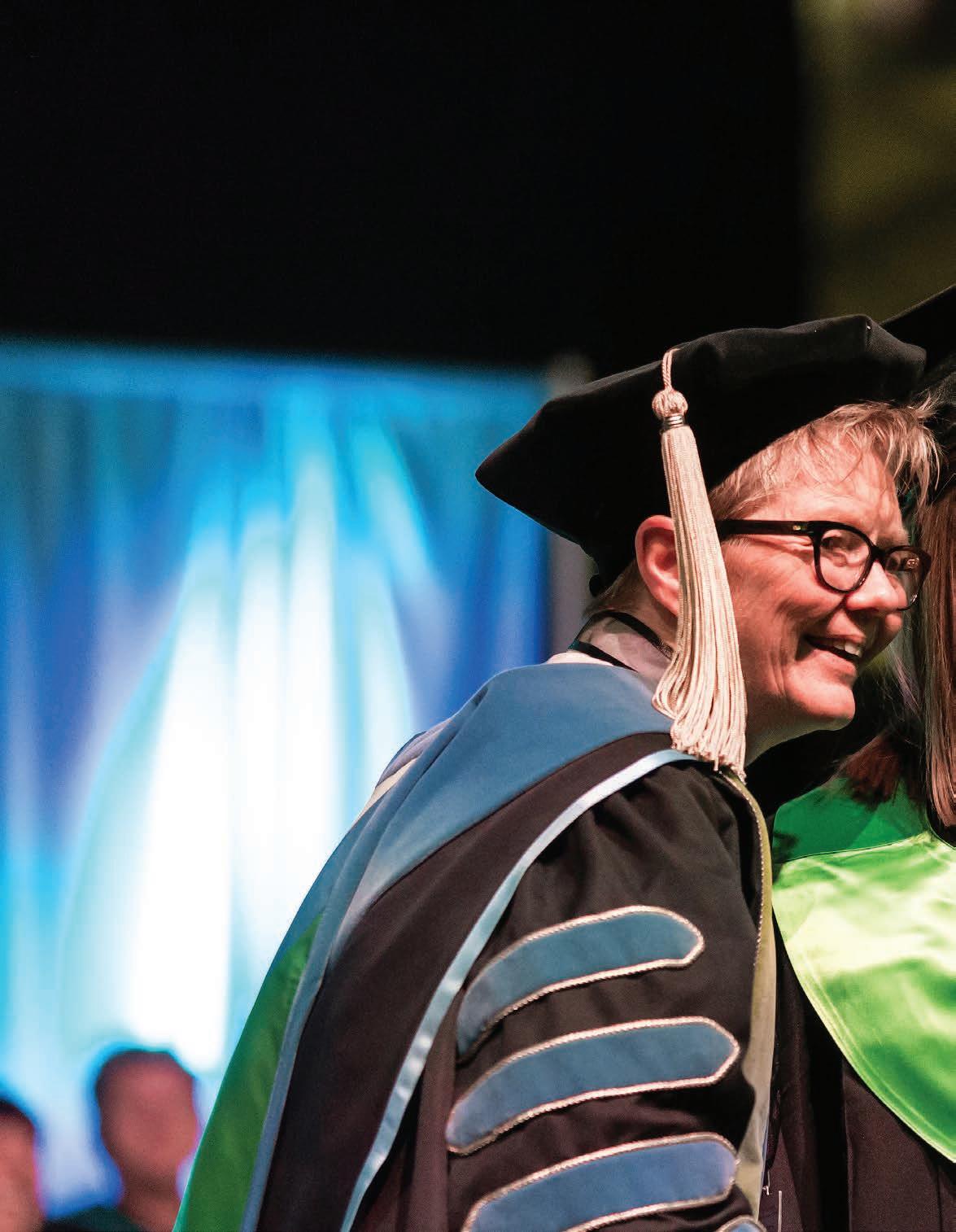
President in action 2 | FALL 2018
“I could not have imagined on the day she was born that I would be the one awarding her a college diploma one day. It’s a pretty amazing feeling. …I am so very proud of her – not just for her academic achievement, but for her strength and dedication, her humour and kindness, for being able to dig deep and rise up.” She then addressed her daughter, saying “Karleen, like every parent here today, I can’t wait to see what amazing things you accomplish next.”
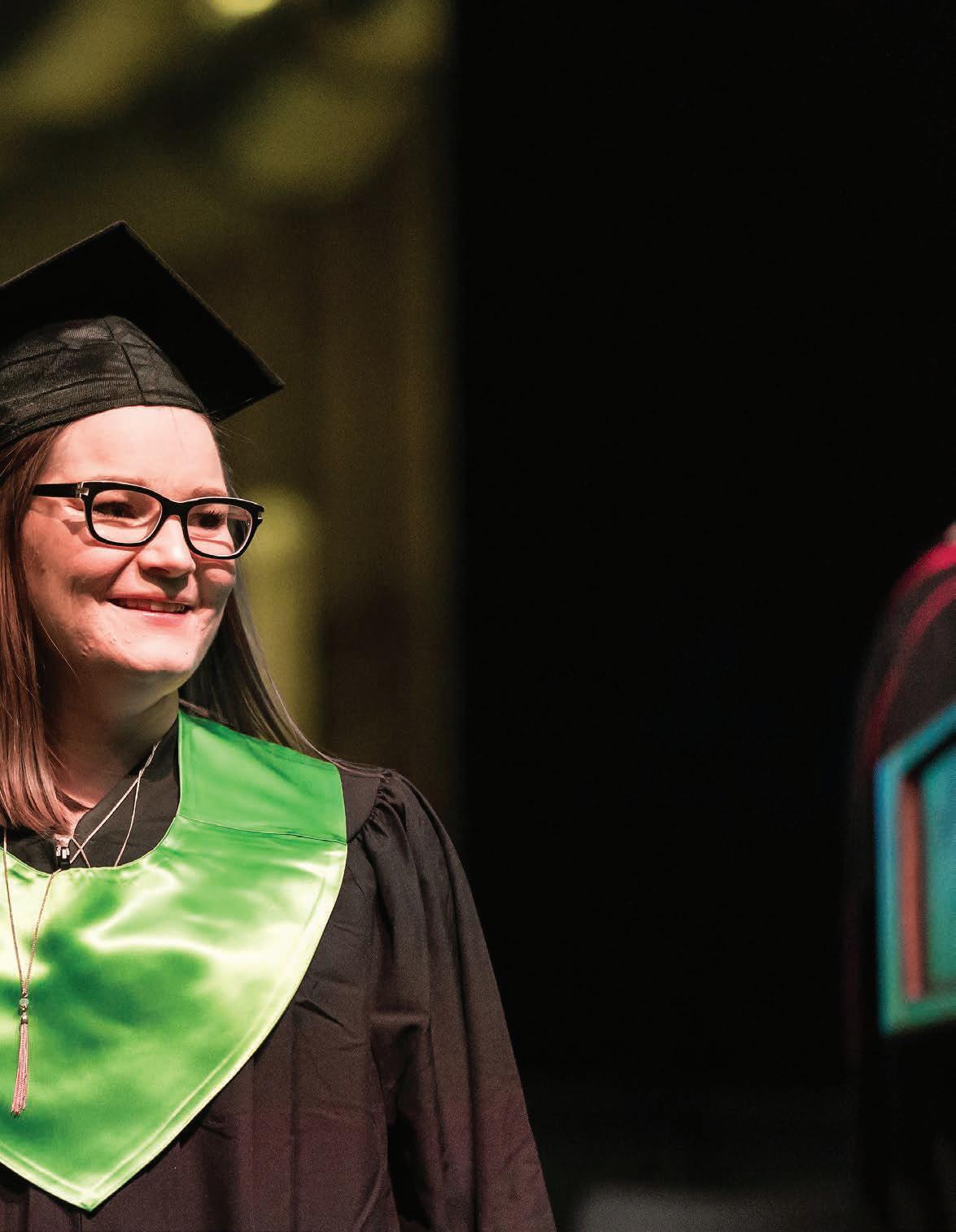
3
Photo by Gregory Thiessen
Back to school sometimes means back to the welding booth. The Welding shop in the college’s new Trades, Technologies and Innovation Facility has 60 welding booths where apprenticeship students learn a variety of different welding processes to prepare for careers as welders. Before the new building opened in 2017, students would learn the operations at various booths; these state-of-the-art multi-process booths allow students to remain in place as they practise any of the different processes.
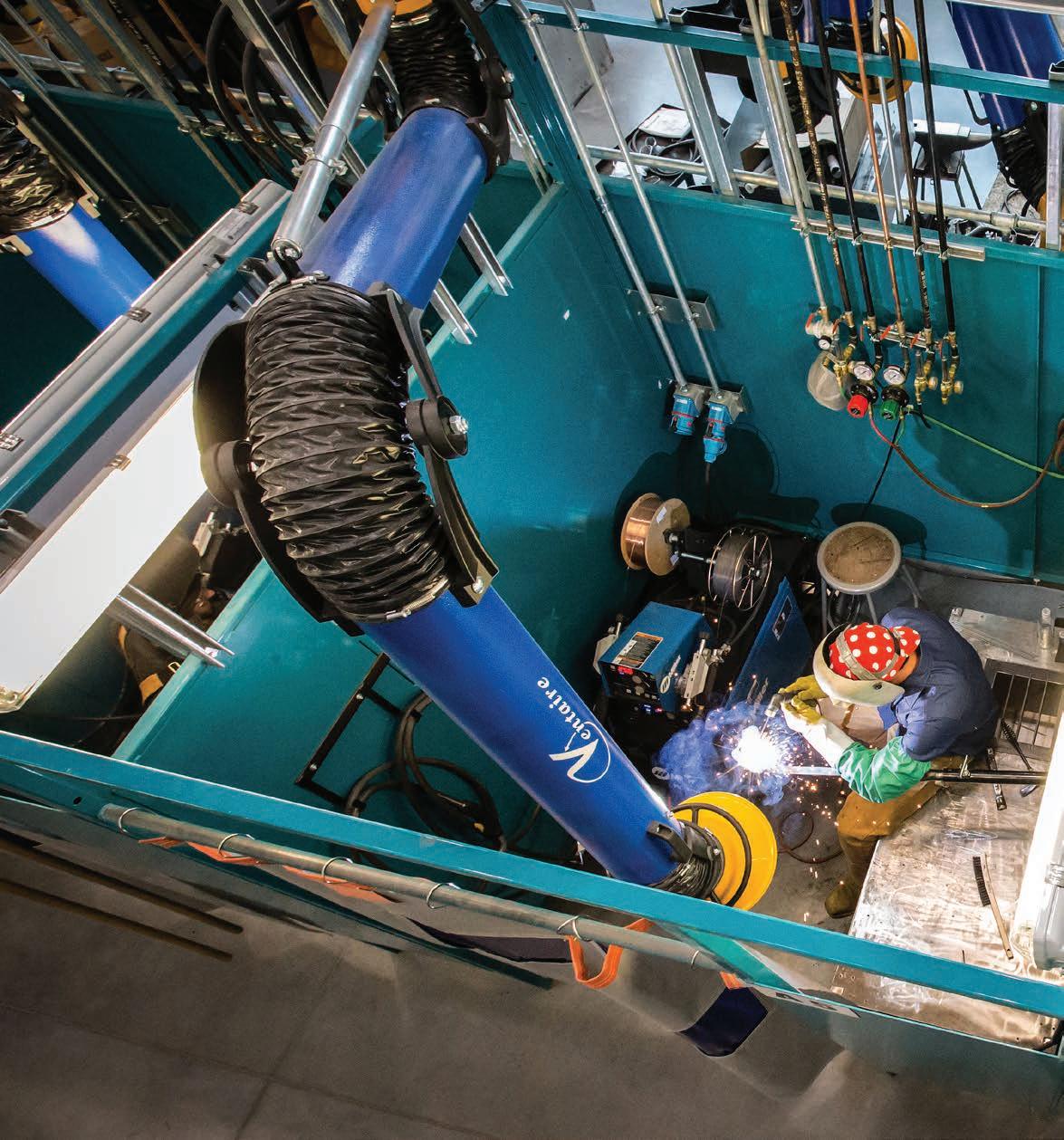
4 | FALL 2018
Campus in season
The two welding students shown below are practicing their skills with the Shielded Metal Arc Welding process, one of several welding and cutting processes students learn in their second year. Welding is one of nearly a dozen apprenticeship programs offered by Lethbridge College. Other apprenticeship programs include Agricultural Equipment Technician, Automotive Technician, Baker, Carpenter, Cook, Electrician, Heavy Equipment Technician, Parts Technician and Plumber.
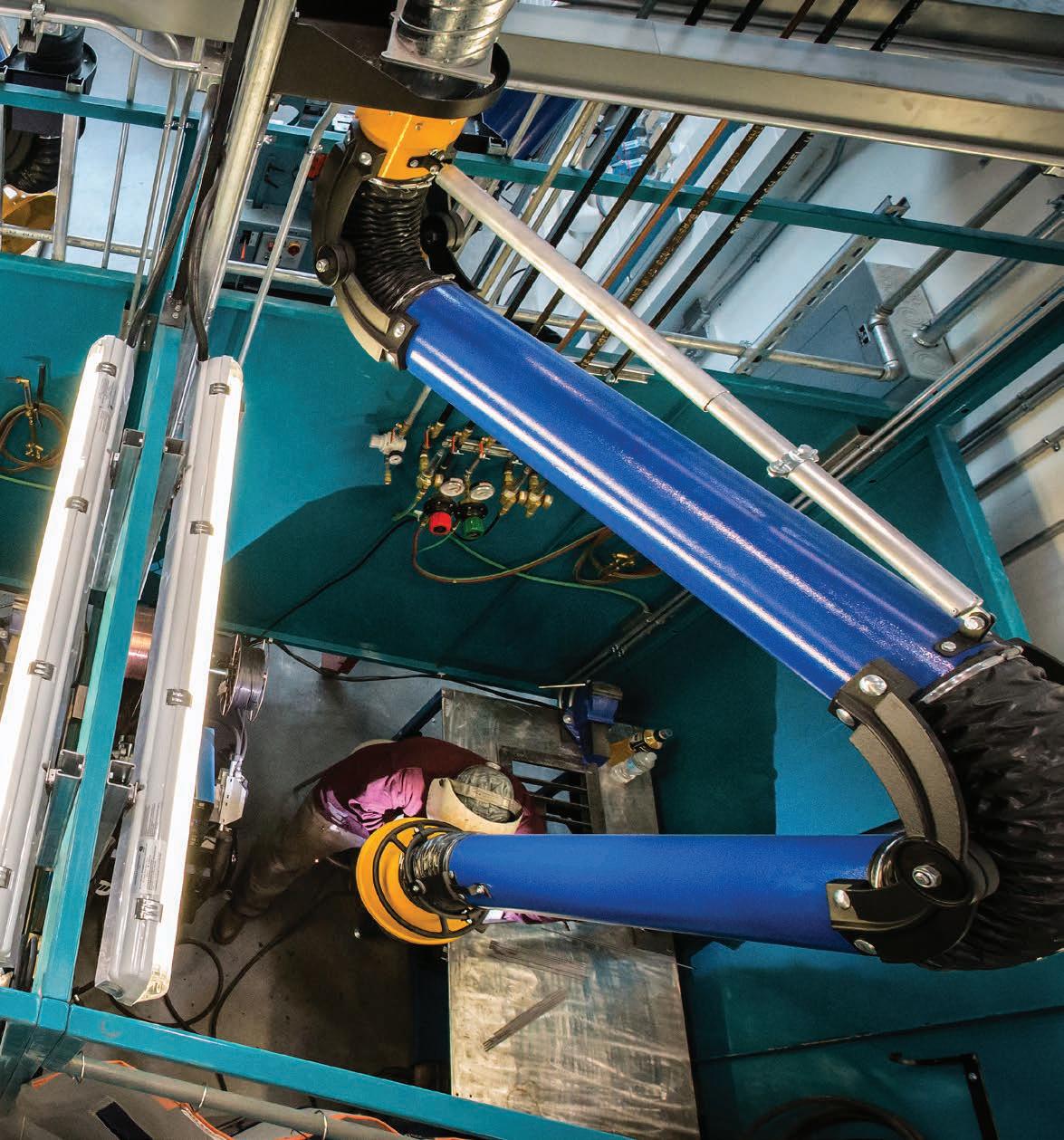
5
Photo by Gregory Thiessen
News and notes
SEEING WHAT OTHERS MIGHT MISS
n nearly any irregular surface – a coffee-stained napkin or a randomly textured wall or fabric – Alvina Roberts sees what many others might miss. From the Pizza and Pasta Counter in the college’s food court, she sees the shapes of people, faces, birds and more. Even in the faces of people at the counter, she has a knack for reading joy, sadness or frustration, all in the span of a quick lunchtime transaction. More than just seeing, she is connecting, whether through her art or a well-timed caring word.
Roberts says her love of painting landscapes and sketching with crayons, pens and pencils spans as much of her 72 years as she can remember. Sometimes, she gets started on a picture by “dabbing.” She might crumple up plastic wrap and dip it into a light paint wash, dabbing the colour onto her paper. She lets it dry then sees what scenes emerge.
She admits to struggling in the darkness of a bad breakup back in 2012. To find a happier space, she began spending extra time at her workplace. For the past six years, she’s arrived to work in Food Services nearly an hour before her shift begins, setting up at a back table to colour or draw. Sometimes, students will approach her to watch or join in. Other mornings, she just draws in solitude against the background noise of students and staff arriving for their morning coffee or breakfast. “I like people,” she explains. “I could do this at home, but I’m alone at home.”

Her roles at Lethbridge College have changed over the years. In 2005, she came to the college as a student in the health care aide program, graduating in 2006. In 2009, she joined the staff of the on-campus day care. The following year, a position opened in Food Services and she juggled both jobs before settling in at the food court full-time in 2011. “I really, really love my job here,” says Roberts. “I love the staff. I love the people I work with. I love the students. I love my job.”
Her caring for people shows in the connections she makes. She recalls one student coming to the counter looking sad. “I asked,
‘How are you?’ and she told me she was thinking about quitting,” Roberts recalls. “I said ‘If you don’t like what you’re taking, don’t take it next year, but finish this year.’ ” That student, Bethany Conrad, persevered and walked across the stage at Convocation in April. Conrad, who completed the Digital Communications and Media program, says Roberts was in her thoughts on that day of celebration.
“Had it not been for her, I would have dropped out,” Conrad says, noting two other confidantes were also key to her support system. “I felt like I could trust her. She really helped me. She’s really caring and she’s a good listener.” Conrad says she tends not to be open with her emotions, but somehow Roberts could read her in the brief minutes they were together. Over time, she estimates she received dozens of pep talks from Roberts. “She just had this way with words that really helped me out.”
O
Story by Dawn Sugimoto | Photo by Gregory Thiessen
News and notes
Whether it’s a one-of-a-kind picture, a caring word or a plate of pasta, Alvina Roberts serves up what people need in that moment.
6 | FALL 2018
Want to keep up on all of your Lethbridge College news between issues of Wider Horizons ? Check out our news and events webpage (lethbridgecollege.ca/news) for the latest stories and all of the college news you need. And don’t forget, you can read past issues of Wider Horizons at widerhorizons.ca.
Kodiaks athletes excel academically
Nine Lethbridge College Kodiaks athletes mastered the balancing act of scoresheets and school books this past year and were named Canadian Collegiate Athletic Association (CCAA) Academic All-Canadians. The award is the most prestigious student-athlete honour in the conference and the Alberta Colleges Athletic Conference (ACAC) saw 41 athletes recognized, with the Kodiaks leading the pack.
“Having our student-athletes recognized not only for their agility and athletic prowess but their dedication to their studies shows that Lethbridge College is producing well-rounded and industry-ready students,” says Samantha Lenci, Lethbridge College Provost and Vice President Academic.
“The Kodiaks operate on three core-concept pillars, of academic accountability, athletic excellence and student-athlete experience,” says Todd Caughlin, manager of Athletics, Residence and Recreation Services. “There is a reason student comes before athlete when we refer to student-athletes.”
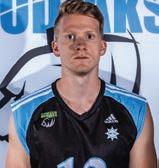
The 2017-18 CCAA Academic All-Canadian award recipients are: Keanu Funa, basketball; Michael Clemons, basketball; Amy Arbon, basketball; Sophia Nowicki, cross country; Emily Spencer, cross country; Braydon Jetten, soccer; Kohl Wandyka, soccer;
Ward, Whitehead named top student-athletes
A pair of volleyball veterans soared above the crowd to earn top student-athlete honours for the Lethbridge College Kodiaks. Kristine Ward won female honours for the 2017-18 season, while Dax Whitehead earned the nod on the men’s side at the KODI Awards in April. Whitehead and Ward each earned the Tim Tollestrup Leadership/Athlete of the Year award. Named after long-time Lethbridge College athletic director Tim Tollestrup, the awards honour the student-athletes who best combine the three pillars of Kodiaks athletics: academic accountability, athletic excellence and the student-athlete experience.

Kristine Ward, volleyball; and Matthew Primrose, volleyball, who says this will likely be the most notable award he will receive during his time at the college.
Additionally, 40 athletes from Lethbridge College received recognition from the ACAC for participating in collegiate athletics and maintaining a 3.3 GPA in the 2017-2018 academic year.
“It is our job as a learning establishment to set young people up for the rest of their lives, not just countdown their five years of athletic eligibility and send them out with no industry skills,” said Lenci. “It’s not enough to slap a Kodiak on their shirt and tell them they’re an athlete. We also need to put a pen in their hands and tell them they’re extraordinary.”
The KODIs celebrated all aspects of another very successful Kodiaks season, which saw the program earn 34 conference or national athletic and academic honours.
Other major KODI awards included:
• Outstanding team – Men’s volleyball
• Coach of the year – Greg Gibos (men’s volleyball)
• Best championships performance – Women’s futsal silver medal at ACAC championships
• Best upset - Men’s basketball beating undefeated and nationally top-ranked SAIT on the Trojans’ home court
• Best comeback – Men’s volleyball rallying from down 0-2 to beat King’s University in the ACAC quarterfinals
Kodiaks Association supports student-athletes with $50,000

The Kodiaks Association has long been Lethbridge College Kodiaks Athletics’ largest fan club, but the group’s cheering has often been done silently. Now the association is making more noise with a $50,000 multi-
faceted gift to support student-athletes.
“The Kodiaks Association has been involved every year but haven’t really been properly noticed, acknowledged or recognized for the work they do,” says Todd Caughlin, manager of Athletics, Residence and Recreation Services. “To take this step, which is so student-athlete focused, you really couldn’t ask for a better show of support. The studentathletes are the ones who will benefit from this the most, which is crucial for us to get better as an entire department.”
The largest portion of the gift is the purchase of new athletic therapy equipment that will benefit all Kodiaks student-athletes. This includes a therapy tub, two Game Ready therapy systems that help with injury rehabilitation and a variety of smaller pieces of equipment. Combined with the installation of a full-time athletic therapist beginning in the 2018-19 season, Lethbridge College can now offer a therapy program that Caughlin believes is as good as any institution in the Alberta Colleges Athletic Conference (ACAC).
KODIAKS NEWS
7
Local home builders contribute over $800,000 to Lethbridge College


An innovative campaign that brought together local home builders, tradespeople and suppliers to support college students raised $804,343 over the past five years. The total was announced in June as the completion of the College Home project, a partnership between the Canadian Home Builders’ Association –Lethbridge Region (CHBA) and Lethbridge College, was celebrated at the college.
Launched in 2013, the program involved CHBA builders working with suppliers and tradespeople to build homes that were showcased and sold. Each builder then made a donation from the proceeds of the sale to Lethbridge College. Eight homes were built over five years and the final combined donations surpassed the initial goal of $750,000. The project was the first of its kind in Canada. Proceeds from the sale of homes supported the construction of the 168,862 square foot, $77-million Trades, Technologies and Innovation Facility, which opened in September 2017. “This project is a testament to what can happen when like-minded individuals get together and create something meaningful,” says Mike Schmidtler, CHBA Lethbridge Region President. “Our industry requires advanced training that is adaptable and relevant. We
are pleased we were able to partner with Lethbridge College to help create a facility that makes that training a reality right here in Lethbridge.”
Seven different home builders led builds over the course of the project. They are Ashcroft Master Builder (year one), Avonlea Homes (year two), Daytona Homes (year three), Empire Homes (year four), Galko Homes Master Building (year one), Signature Homes (year three) and Stranville Living (years two and five). In addition, 147 suppliers and tradespeople contributed to the builds, including six that each contributed more than $30,000 worth of resources over the course of the project: All Weather Windows, Challenger Building Supplies, Exteriors by Leroy and Darcy Ltd., KB Heating and Air Conditioning, Kodiak Heating and Air Conditioning/Kodiak Plumbing and Gasfitting Ltd., and Neu-Lite.
Lions Club gift set to help visually impaired students
Lethbridge College has received a $50,000 gift from the Picture Butte Lions Club to support students on campus with visual limitations.
The Ron LeClaire Memorial Award is named in memory of a long-time Picture Butte Lions Club member and will be used to create scholarships for students who are blind or visually impaired.
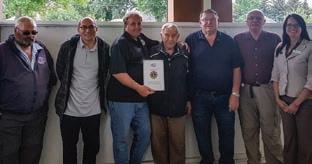
Ron LeClaire worked as a hotel owner in Picture Butte and Milo and was an active member of the Picture Butte community before he passed away in 2011. “Ron was a community-minded gentleman,” says Picture Butte Lions Club President John Koenen. “He attended absolutely everything that was going on in town – it didn’t matter what kind of activity. You could look around and you would see Ron was always there.”
The Lions Club researched many causes and institutions before deciding how to best honour LeClaire’s legacy, as the organization he had specified in his will no longer existed. “So our dilemma was how to use the money to respect Ron’s wishes,” says board member Doug Jackson. “A friend suggested a scholarship so I came down to the college and checked it out. It was a great fit to support students right here in southern Alberta who face barriers in their education due to vision impairments. You often hear people say, ‘give a man a fish and you feed him for a day; teach a man to fish and you feed him for a lifetime.’ That’s why it was important for us to partner with an institution that is giving individuals the tools necessary for success.”
Lethbridge College students with visual impairments are supported by the campus’ Accessibility Services department, which provides students with flexible, innovative and collaborative learning opportunities by creating custom pathways to academic success. Its services support a wide range of diverse learners, including those with physical, sensory, learning and developmental impairments. The Lions Club contribution will help to support students who depend on Accessibility Services to assist in their learning journey.
Since its creation in 1917, Lions Club International has focused on aiding communities with issues of vision, hunger, the environment, childhood cancer and diabetes, and is recognized as the world’s largest service club organization. Aiding those affected by vision impairments is a special priority. The Picture Butte Lions Club members hope the gift attracts visually impaired students who may otherwise have had to travel away from home to continue their education. “We would like to see someone’s life – or many lives – improve because of this gift,” Jackson adds.
Jun. 13 : @josievanlent
How do you get a bison to behave?!! Enjoying our tour of the Lethbridge College wildlife collection with myCADAP colleagues!

News and notes
PHILANTHROPY 8 | FALL 2018
{ Josie Van Lent }
Stranville Living makes major donation
The sale of a new home in west Lethbridge has led to an $81,002.65 gift from Stranville Living Master Builder to Lethbridge College as part of the final year of the College Home project. The lead builder and returning partner announced the donation May 22.
The College Home project began in early 2013. In five years since its launch, the Canadian Home Builders’ Association (CHBA) – Lethbridge Region and Lethbridge College partnered with regional builders, local tradespeople and suppliers to build and sell eight homes. Each builder then made a donation from the proceeds of the sale to Lethbridge College to support the recently completed, $77-million Trades, Technologies and Innovation Facility.
Throughout the College Home initiative, Stranville Living was the only builder to take the lead on multiple homes, having previously taken part in year two of the project. The sale of Stranville’s home marked the conclusion of The College Home project.
Alumnus hopes donation of wildlife collection inspires college students
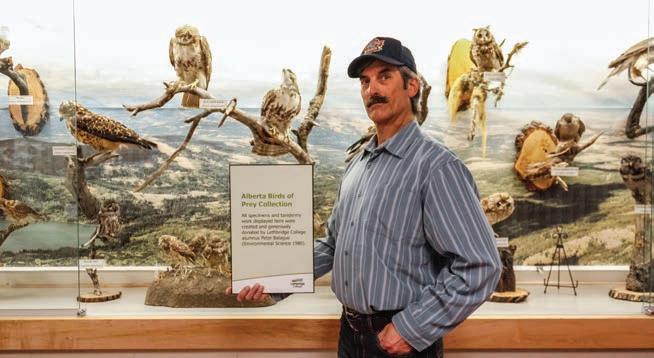
An appraiser pegged the value of a collection of mounted raptors at about $18,000, but if you ask David Haight, this donation to Lethbridge College is priceless. Haight, coordinator of the labs in the Cousins Science Centre, says the 24 birds of prey displayed on the second floor of the building, represent just a fraction of alumnus Peter Balagus’s gift.
Balagus (Environmental Science 1980) also gave a cabinet full of about 200 other specimens including small mammal skins, skulls and skeletons, and bird skins and wings;
each carefully catalogued and preserved. They are not on public display but students can access them for study. Such access allows students to see for themselves the subtle differences between species and genders of the same species.
Balagus recently visited the college with his wife Colleen, who was making her first visit to campus. They emerged from the Cousins Building stairwell to be greeted by the raptor display, set against a panoramic photo taken from Table Mountain. The photographer was college lab technician Jonny Friesen, who organized the display. “The background is beyond what I anticipated,” Balagus says. “It’s absolutely fabulous. It’s humbling and moving.”
Lethbridge College’s Agriculture Entrepreneur in Residence program inspires agricultural innovation, one student-entrepreneur at a time.
Students involved in AgENT have the opportunity to be agents of change in the agriculture industry. Learn more, including details about our Sept. 13 kickoff as well as how to be a partner in this one-of-a-kind opportunity, by visiting lethbridgecollege.ca/agent lethbridgecollege.ca/agent

/LethbridgeCollege @lethcollege
Stay connected to Lethbridge College all year long by following us online. Follow us at:
@lethcollege lethcollege
9
WORKING TOGETHER
IT’S A WIND-WIN
On many southern Alberta roads, you can hear the familiar hum of an energy-producing wind turbine in the distance. For 15-year-old Foremost student Jordan Kurtzweg, the sound of the turning blades ignited a cerebral spark.
“They are considering building a wind turbine farm in my area, and when I heard that, it immediately got me thinking about the science side of it all,” Kurtzweg says
So for this year’s science fair, he dove into researching the angles of wind turbine blades which would produce the most electricity, the logistics behind storing energy during non-peak times for future use and the applications of his research in various climates.
The project, “A wind-win,” was a success, and he was asked to present his findings in Ottawa at the Canada-wide Science Fair in early May.
In the months leading up the national competition, the teenage innovator, who had been testing his wind theories with a household fan in his father’s workshop, reached out to instructors in Lethbridge College’s Wind Turbine Technician program for guidance. Instructors Chris DeLisle, Gordon Bourgoin and Ronald Papp were thrilled to be project advisors and invited the eager learner to campus to use the world-class facilities.
“Once we met Jordan and saw his passion, it got us excited to be a part of the project. Seeing young people take an interest in the industry always gets you fired up,” says DeLisle. “This experience showed me that just giving a small amount of time can have a significant impact on others.”
After having the opportunity to test his hypothesis in the Lethbridge College wind turbine tunnel and collaborate with his new team of mentors, Kurtzweg ventured east for the national science fair, where he was awarded a $750 renewable energy award.
“To have people recognize that something I had put so much work into had the possibility to make a difference was great,” says Kurtzweg. “My findings couldn’t have been as accurate without the help of Lethbridge College.”

“They are considering building a wind turbine farm in my area, and when I heard that, it immediately got me thinking about the science side of it all.”
News and notes 10 | FALL 2018
Story and photo by Stephanie Savage
Remembering Lethbridge College’s early faculty
Health Care Aide program expands to meet demand
Justice Studies instructor and students head to Croatia

A Lethbridge College instructor served as part of the faculty for one of the world’s leading post-graduate criminal justice courses this past summer. Aaron Eyjolfson, an instructor in the School of Justice Studies, presented at the 34th annual Postgraduate Course of Victimology, Victim Assistance and Criminal Justice in Dubrovnik, Croatia, in May.
Eyjolfson arranged for five students from the college’s Justice Studies – Bachelor of Applied Arts degree program to attend the course. The course resulted from a partnership between the Inter-University Centre and the World Society of Victimology. It brought together approximately 50 internationally renowned experts who offered insight into the plight of victims around the world.
The five students – Jordayne Andrew, Angelica Lai, Desiree Trost, Megan TurnerChristianson and Jay Wingrove – are all completing the four-year Justice Studies –Bachelor of Applied Arts program at the college. The course ran from May 7 to 19 and included cultural and sightseeing trips in addition to the formal learning opportunities.
High school students immersed in college experience
Experiential Learning Week returned to Lethbridge College for a third year, bigger than ever. The week of May 7 to 11 saw nearly 200 high school students from nine area high schools taking part in college-level programs in an area of individual interest. Students chose from one of 13 educational tracks, encompassing nearly every Lethbridge College program — from trades to agriculture, health and wellness to justice, business to environmental science. Students received high school credits for their participation.
Lethbridge College lost two of its long-time and early faculty members in recent months. Ken Riley was the first faculty member hired by Lethbridge College to create its Law Enforcement program in 1969. A former RCMP member, he served as founding chair of the Law Enforcement program. He retired in 1987. Riley passed away May 8 in Lethbridge at age 91. Former colleagues Ann Parks and Roland Barber remembered Riley as a bighearted, highly intelligent and fair person. One of Riley’s contemporaries from the automotives program, Helmut (Hal) Hoffman, passed away May 6 in Calgary. He was 83. He taught at Lethbridge College from 1964 to 1991 and was a former president of the Faculty Association.
If you have news about former Lethbridge College faculty and staff members that you’d like to share with readers of Wider Horizons, email WHMagazine@lethbridgecollege.ca.
Police cadets graduate from collaborative program
The graduation ceremonies of the 2018 Medicine Hat Police Service (MHPS) and Blood Tribe Police Service (BTPS) Cadet Training program took place in Medicine Hat May 25. Eleven cadets took part in the 20-week training program, including eight MHPS cadets and three BTPS recruits, who met or exceeded provincial standards in the areas of police recruit training. The cadets also received academic accreditation through Lethbridge College for the knowledge and skills they have acquired through this competency-based educational program. The program is the result of a collaborative partnership between the MHPS, BTPS, Lethbridge Police Service (LPS) and Lethbridge College. Although a traditional classroom environment played an important role, much of the learning and assessment took place in real-life settings throughout the community, which makes the program unique.

To meet industry demand, Lethbridge College is expanding available seats in one of health care’s fastest-growing professions. The Health Care Aide certificate program will increase the number of available seats from 24 to 30 and will also add a new part-time online cohort for 16 students. Two factors led to the decision to add the new seats: the popularity of the Health Care Aide program among prospective students and a strong demand from employers. The online offering will provide the same benefits as the traditional program, while giving rural learners and those unable to attend full-time classroom lectures a chance to continue their studies.
Students survey pioneer village as part of new partnership
A new partnership between Lethbridge College and the Prairie Tractor and Engine Museum Society gave Geomatics Engineering Technology students a true taste of surveying challenging terrain in winter conditions. Bill Smienk, chair of the School of Engineering Technologies, says the college’s agreement with the society, signed earlier this year, saw students survey the Coyote Flats Pioneer Village property near Picture Butte. Aside from giving students practical and purposeful work for an actual client, the partnership has potential for future student efforts, including applied research. Pieter van Ewijk, general manager of the pioneer village, says the students’ efforts were important to the society, which operates entirely on grants and donations. Instructor Andrew Bowen and technologist Jim Pinches accompanied about 20 second-year students to the property twice in the weeks before and after Easter, where they experienced challenges that included unseasonable cold and snow. The museum opened for the season May 19.

NEWS AND EVENTS 11
Pride celebrated at college
A rainbow took flight at Lethbridge College in June as members of the college community gathered for the annual raising of the Pride flag. This is the third year the college has flown the colours of inclusion to show its support for LGBTQ+. “We are proud to show our continued dedication to promoting equality and diversity on campus,” says Dr. Paula Burns, Lethbridge College President and CEO. “By hoisting the flag, we are not only saying we support our LGBTQ+ students and partners, but that we embrace all people in this community.”
In addition to the raising of the flag, the college proudly displayed an interactive art piece commissioned by the Lethbridge Pride Fest committee on campus from June 12-15. The piece combined the word PRIDE with an additional heart to represent the six flag colours. Each character was created by a local artist and expressed what it means to be an LGBTQ+ individual. The art piece was featured in Centre Core for people to view, explore and snap photos with.
The college also took its support of Pride off-campus as volunteers banded together and marched in the Lethbridge Pride Parade for the first time. Members of the leadership team, faculty, staff and students – and their pets –faced the rain to walk together as a symbol of solidarity and support, wearing newly designed college pride T-shirts.
And at the conclusion of the week, Tara Ludman and Zachary Wigand, president and vice president of the LCSA’s LGBTQ+ Club, received a Lethbridge Pride Award in the Youth Leadership category for their work in the college community. This award recognizes those aged 18 to 25 whose leadership demonstrates a commitment or significant contribution to the region’s LGBTQ+ community.
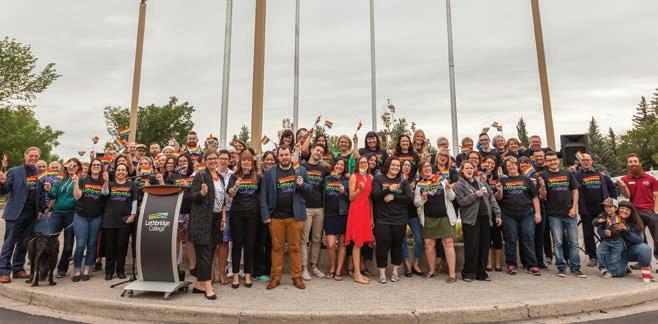
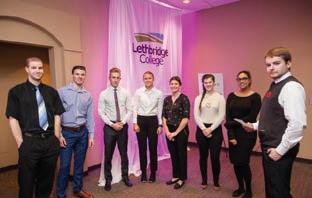
Innovative Police Cadet Training program earns national gold award

Lethbridge College received a gold Program Excellence award in April at the Colleges and Institutes Canada (CICan) annual conference in Victoria. The award was for the competencybased Police Cadet Training program. The innovative and collaborative program meets the specific needs of southern Alberta police services and is the only police training program of its kind at a public college in Canada.
The Police Cadet Training program was designed to meet industry demand for officers who had mastered both hard skills, such as firearms use, and soft skills, such as interpersonal communication, ethical accountability and teamwork.
The program launched in March 2017, following consultations that began with the Lethbridge Police Service (LPS). An initial
intake of 10 LPS cadets took a 17-week program at LPS headquarters. By graduation, eight members of the class successfully demonstrated their competence to take on the role expected of them as front-line officers.
Fashion in focus at “I’ll Show You Mine” event
There was plenty of glitz and glamour in April as Lethbridge College and the University of Lethbridge presented the second annual “I’ll Show You Mine… Deconstructing Costume, Constructing Fashion” event. The one-of-a-kind show combined the college’s annual fashion show with a collaborative art exhibition and was presented by the college’s Fashion Design and Sustainable Production program and the U of L’s Dramatic Arts program. It featured student-created fashion designs and art exhibits created by students, instructors and alumni.
In its 50th year, LEO Club raises nearly $8,000
During its 50th year, the Criminal JusticePolicing students in Lethbridge College’s LEO Club wanted to give back even more than usual to their community. They did just that, taking part in more than 40 volunteer events, providing more than 1,000 hours of volunteer time and raising nearly $8,000 to support a dozen different community and global organizations.
The LEO Club at Lethbridge College was founded in 1967 by Ken Riley as part of the Lions Clubs International. The word “LEO” stands for Leadership, Experience, Opportunity and links precisely to the goals and priorities of many students in the Criminal Justice - Policing program. The local organizations that received support from the LEOS this past academic year include the Lethbridge College Students’ Association Food Bank, YWCA Lethbridge and District, Lethbridge Boys and Girls Club, Lethbridge Ability Resource Centre, Lethbridge Schizophrenia Society, Lethbridge Big Brothers/ Big Sisters, Lethbridge Family Services and Lethbridge Police Victim Services.
Jun. 12 : @rogalskymtr
At Lethbridge College’s McCain Foundation Simulation Collaboratory exploring potential of Virtual reality tec for teaching in Ag
News and notes News and notes 12 | FALL 2018
{ Michele Rogalsky }
First winners of Ashcroft Design Challenge announced
Two Interior Design Technology (IDT) students have been named the inaugural winners of the Ashcroft Design Challenge. First-year designer Lina Wiebe and second-year animator and virtual reality creator Jada Kot were selected as the winners by a panel of judges from Ashcroft Master Builder.

Students were tasked with designing a home that combines modern elements with real-life considerations such as construction costs and marketability. Wiebe and Kot’s winning design, The Emberly, will now be built by Ashcroft, with the two students earning the opportunity to work on the project as interns. The proceeds from the sale of the home will be donated back to the college.
The Ashcroft Design Challenge was launched as a one-of-a-kind opportunity for Lethbridge College students. Each first-year student created a home design and was then paired with a second-year student who brought the design to life. Representatives from Ashcroft chose the three finalists and selected the winners. The Ashcroft Design Challenge is another example of the industry partnerships that are vital to Lethbridge College’s success. By working closely with a company that frequently hires graduates, students gain exposure to a potential employer, while receiving industry-specific training.
Building language skills at LC
Two groups of about 75 people from Quebec immersed themselves in the English language and experienced southern Alberta culture from a home base at Lethbridge College this summer. The participants lived and learned in Lethbridge for five weeks as part of the Explore bursary program that encourages them to build language skills and discover another part of Canada.
Lethbridge College English Language Centre manager Michelle Derbich says the Quebec students were among nearly 300 students participating in the English program on campus this summer. Other short-term learners are attending from Japan and longer-term students include newcomers to Canada, Canadian citizens and international students who are learning English as a second language.
COMING UP on CAMPUS
Saturday, Sept. 15
Coulee Fest
Join us on campus at our free, fall community celebration. Live music, beer gardens, street market, food trucks, family activities, campus tours and more! For more information, visit lethbridgecollege.ca/couleefest

Thursday, Oct. 18
Indigenous Celebration Day
Celebrate the pride, history and knowledge of our Indigenous community on campus. Features traditional entertainment, displays and food, celebrating all of the region’s Indigenous cultures. For more information, visit lethbridgecollege.ca/indigenous.
Friday, Nov. 2
Kodiaks Junior/Senior High Night
Free admission to Kodiaks men’s and women’s volleyball games for all junior and senior high school students and their chaperones. Includes a free BBQ and drawings for great prizes. For more information, go to gokodiaks.ca.
Thursday, Nov. 8
Fall Open House
Experience the hands-on environment that gives students the leading edge and join us for a day of exploration and discovery. Campus tours, faculty representatives, interactive program areas and more. For more information, visit lethbridgecollege.ca/openhouse
FALL EVENT SCHEDULE 13
Congratulations to these Lethbridge College community members making a difference:
Melanie Hamilton, research lead, Scholarship of Teaching and Learning (SoTL), has been named to the SoTL Canada Board in the position of vice-chair.


Karla Wolsky, chair of the School of Allied Health, presented at the fourth International Conference on Nursing in Athens, Greece, on “Can Students Who Choose to Participate in Acts of Academic Dishonesty Have the Ethical Compass Necessary for Their Future Nursing Careers?”
Dr. Kenny Corscadden has been appointed the new Associate Vice President of Research at Lethbridge College. Corscadden joined the college in August 2017 as Dean of the Centre for Technology, Environment and Design. He will continue in that role, while also taking on the AVP Research portfolio.


Dr. Jeanine Webber has been named the new dean for the Centre for Justice and Human Services. She joins the college from Humber College and began her new role in June.

Kris Hodgson, chair of the School of Media and Design, led a plenary session at the Radio Television Digital News Association’s National Conference and Awards Gala in Toronto on how 360-degree storytelling is helping the world with empathy and understanding of global events.
Ashley Cesar, Harmoni Jones, Marie Laenen, Karla Wolsky, Sheri Wright and Janet Yorke, who presented at the Canadian Association of Continuing Care Educators Conference in May, which was hosted by the college.
Karma Black, Andrew Derksen, Cynthia Halligan and Rylan Spenrath presented at the Learning Specialist Association of Canada’s 2018 Western Region conference held in May at the University of Lethbridge. The conference was for academic counsellors, disability specialists, learning strategists, or any person working with students on academic skills and learning strategies.
five
Students who competed at the Provincial Skills competition in May. Congratulations to Arnond Avila, finished eighth in Heavy Equipment Services; Amanda Craig, finished sixth in culinary arts; Jacob Hutchinson, competed in plumbing; Henry Klok, finished fourth in carpentry; and Ty Odney, competed in welding.
480
Donors needed at Canadian Blood Services in Lethbridge in June, during the #MissingType initiative (which the college took part in)
NEARLY 700
Number of students who attended Convocation
$ 1,000
Number of dollars of tuition credit students in the first Agricultural Enterprise Management classes will receive this year
1,520
May 24 : @_CACCE
Ashley Cesar, HCA instructor at Lethbridge College presenting at the CACCE Conference on Bridging The Gaps From Theory to Practice Through Simulation. Excellent job Ashley { CACCE }

Number of students who graduated in 2018
427.9 million dollars that Lethbridge College added to the region during 2015-16

News and notes
CAMPUS KUDOS
BY THE NUMBERS
14 | FALL 2018
a word or two
…about being a new student at Lethbridge College
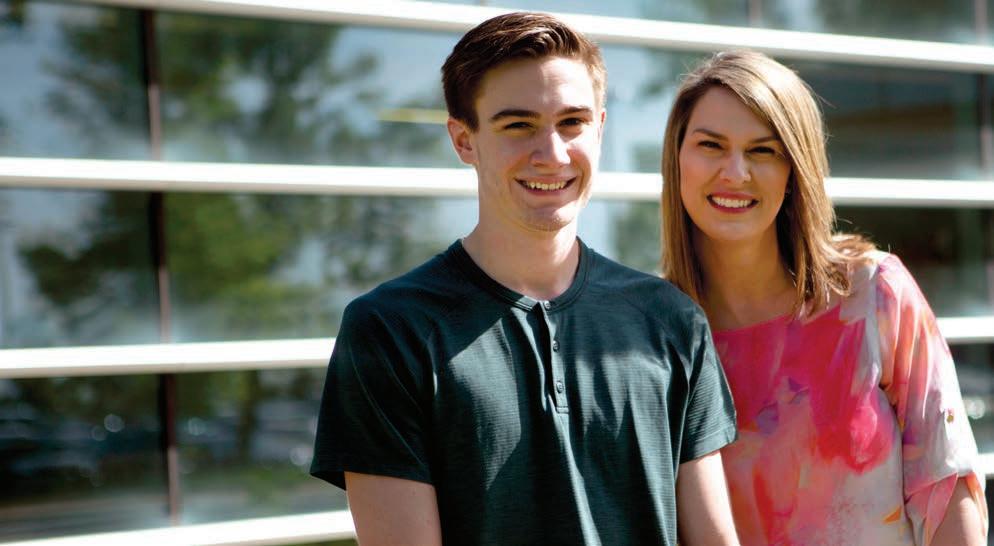
In this digital-first era, the gap between parents and their children may seem to be widening. But the fact is that parents are there to bridge the gap between what kids think they know and the life skills they definitely need to have before they head off on their own.
Wider Horizons practicum student (and new grad) Stephanie Savage sat down –separately – with second-year Business Administration student Ethan Davis and his mom, Renata Pittman-Davis , to find out what they thought was important for students to know before they step foot on campus. Here’s what they had to say.
What do you think someone should know before starting college?
Ethan: It’s a lot different than high school. There isn’t someone there to hold your hand through every challenge. While they will still offer help when you need it, it’s more about being independent. I think it’s important to teach that to college students because once you’re in the real world, you have to be able to find your own way.
Renata: That it’s on you now. No one else is going to get the work done for you. Everything comes down to you and only you.
What was your biggest fear before the first day of classes?
Ethan: Well, I’m a bit of a nervous Nelly so there were a lot of things I worried about. It was all just small stuff even if at the time it seemed like everything was a big deal. I realize now I shouldn’t have stressed about it because everything turned out awesome.
Renata: I think the thing that I was most fearful of was that my son would think he failed if he decided this is not the path for him. It’s perfectly acceptable not to get it right on the first go. Sometimes it’s a process of trial and error.
Laundry: who does it?
Ethan: I sometimes do it, but honestly, if she’s doing a load anyway, I might as well just toss my stuff in. I will learn eventually but for now, I just say the biggest thank you when I have clean socks.
Renata: I would rather him not do it. It’s easier if I just do it because then it actually gets done.
What can new students expect their diet to be like once they start college?
Ethan: A lot of pizza, ramen and free food. Just eat as much as you can.
Renata: There is always free food around the college. Ethan comes home most days and tells me, “oh, they had pizza at school today, or popcorn, or hotdogs,” which is good for him because he’s a bit of a garbage can.
And last but certainly not least…
Is it OK to tell your mom you love her in front of your friends?
Ethan: Ya, for sure, my mom is the best. I love her.
Renata: Yes, he should also want to hold my hand from time-to-time. I’m still his mother after all.
A WORD OR TWO
Story and photo by Stephanie Savage
15
Communication Arts alumna says life’s work attests to the value of bold dreams and hard work

I n February 1978, Moji Taiwo left the year-round tropical weather of her home in Lagos, Nigeria, and landed at the snow-encrusted Calgary International Airport. After an exhausting 14-hour flight, she ventured into the arrivals area of the airport. While watching strangers be reunited with their loved ones, she discovered she was stranded.
As the airport slowly emptied out, it became obvious her brother was not coming to meet her. Wandering the airport alone in a two piece skirt suit and open-toed shoes, her first Canadian challenge was to find a way to her new home by herself in the cold.
Story by Mel Lefebvre | Photos by Hero Images
16 | FALL 2018

17
It isn’t Taiwo’s style to wait around to be saved. Instead, Taiwo, a 1981 graduate of Lethbridge College’s Communication Arts – Broadcast Journalism program, took charge and conquered her first challenge as a newcomer to a cold, unfamiliar country. After several hours, she found a taxi that took her to her new address. When she arrived and saw that she was locked out because her brother wasn’t home, she was still unfazed. She simply went to the next-door neighbour to ask for help. Her new neighbour paid the cab fare, welcomed her inside and gave her a winter coat.
Taiwo’s dreams of going to school in Canada had gotten off to a rocky start. But as she proved again and again in her life, Taiwo isn’t easily defeated. Determination and grit are the cornerstones to her success, which she outlines in her new book, I Give because I’m Blessed – I’m Blessed because I Give: A Chronicle of an Immigrant’s Journey
Being an immigrant is a disruptive experience, and additional challenges make finding your place more daunting, like speaking English, which Taiwo initially took for granted. While she spoke fluently, Taiwo’s English dialect had British/ Nigerian nuances, and she found it difficult to be understood. So, while figuring out Calgary’s transit system in the winter so she could find a job, she also focused on adapting the way she spoke. And after one year of working in domestic labour, she was ready to apply for post-secondary education.
Taiwo will never be caught calling these early days difficult, though. “We say challenges – not difficulties,” she says. “You’re being forced to regroup and focus. When you stare at a rock long enough, you begin to see a precious gem.”
On Friday afternoons in the mid 1970s, the school’s corridors in Abeokuta would buzz with hundreds of kids ready to let loose for the weekend. But at Taiwo’s school, the end of the week meant it was time to mow the lawn, by hand, under the intense, tropical sun. Armed with cutlasses (a long blade similar to a machete), each student lined up to slash away at the boarding school’s acres of grass. The weekend only started when the grass cutting was finished. In Taiwo’s last year of high school, as a senior prefect, she no longer had to cut the grass. But she hung back anyway to help the younger students so they could escape the heat more quickly.
In Taiwo’s family, education was prized above all else. Taiwo’s mother saw it as a way out of the traditional WestAfrican life of marrying young and relentless housework. “My mother married in the days where Nigerian girls were identified by who you married,” Taiwo says. “She married young and was not educated, and the family who she married didn’t value education, especially for girls.” Her mother broke with convention and left her first husband, but not before having three children – all girls. None of them achieved anything beyond a Grade 6 education.
“Leaving that union was unheard of, and then she met my father,” Taiwo says. Her parents went on to have five more children – two of them, including Taiwo, were girls. “My mother was still reeling from the fact that her three eldest daughters (from her previous marriage) didn’t have an education, so she especially focused on the two of us. By that time, she wasn’t really a traditional mother anymore,” Taiwo laughs.
Taiwo realized early on that her educational aspirations wouldn’t be satisfied in Nigeria. While there are universities in her home country, she thought her dreams of becoming a broadcast journalist were better served abroad. She learned that Canada offered scholarships for international students and applied. With money she had saved working a year after high school in Nigeria, she made a quick announcement to her parents that she was leaving, and found herself in Calgary in the middle of winter.
To Gani Kareem, Taiwo’s friend from the Nigerian Canadian Association of Calgary (NCAC), this decision was an act of bravery. “Being a young, black woman coming to Canada from a foreign land, where you don’t know people, it’s very impressive,” Kareem says. “Moji has helped so many people. She understands where they are coming from.” It’s easy for new immigrants to give up on their dreams, as Taiwo recounts in her book - especially when faced with circumstances beyond personal control.

In 1979, after upgrading her English at the Western Canada High School in Calgary, Taiwo applied to SAIT’s journalism program, but was rejected (see page 21).

18 | FALL 2018
“We say challenges – not difficulties.You’re being forced to regroup and focus. When you stare at a rock long enough, you begin to see a precious gem.”
 Moji Taiwo’s new book is a memoir that chronicles her journey as an immigrant in Canada.
Moji Taiwo’s new book is a memoir that chronicles her journey as an immigrant in Canada.
19
{ Moji Taiwo }
The interview committee didn’t think she would be a successful broadcast journalist because of her accent. “In those days, this was almost 40 years ago, it was OK to reject somebody because of who they are,” says Taiwo. “The environment in Canada and in Alberta, for that matter, was not readily open to people that looked like me or sounded like me.” But she had also applied to Lethbridge College’s Communication Arts – Broadcast Journalism program, and was thrilled when she was accepted. Newly married, she and her husband, Derin, packed up and moved to Lethbridge to start their new life.
“(The college) was my incubator. Giving me admission actually started everything off,” says Taiwo. “I know who I am, I know who I want to be, I know what I want to contribute, and that pushes me to forge ahead. If you can’t go through (a challenge), you go around it,” she says. Taiwo boasts a permanent smile, and reaps in the best of people because, as she says, “You get back what you put out.”
As an immigrant, Taiwo is regularly burdened by the multiple faces of racism. Even recently, Christi Harter, Taiwo’s next-door neighbour, says Taiwo told her about how passengers on a bus during the Calgary Stampede changed seats once she sat down. And while Taiwo and her husband were younger and living and studying in Lethbridge, they found themselves freezing in the middle of winter because their landlord had been pressured by a neighbour to shut off the heat so they would move.
The college provided a much-needed respite from that treatment, and made her feel welcome and comfortable by treating her like any other student. “We were not only being given education that we paid for – we were also taught how to get along and to look out for each other,” she says. “We had a cohesive, really close-knit group and the instructors, they were phenomenal, especially Mr. Ian Mandin. He took all of us in, like we were his own kids. He especially gave me courage because he didn’t treat me any differently.”
After graduation, Taiwo initially worked at a Lethbridge radio station but says she quickly realized she wasn’t welcome there. So she found another job and applied to the University of Lethbridge to study sociology, and from there embarked on a career in corrections.
What she learned at the college helped form her subsequent career in juvenile delinquency and rehabilitation, where she had a successful career dedicated to serving troubled youth. Working for the Government of Alberta –Justice and Solicitor General from 1984 to 2015 allowed for many opportunities to expand into leadership roles. It also led to several awards, like the Corrections Exemplary Service medal award in 2008 and the Corrections Exemplary Service bar award in 2015, among others.
Taiwo achieved this success despite facing some who tried to hold her back. Harter, Taiwo’s neighbour, has taken up these issues as teachable moments on white privilege.
“Moji’s story is significant to understand how much overt racism there is for people who are not Caucasian,” says Harter, who adds that Taiwo’s life story is an example of what’s possible if you work hard and connect with people from a place of compassion and understanding. Harter also plans to share parts of Moji’s story in the courses she teaches in the education department at the University of Calgary. “Moji says in her book how immigrants don’t often assimilate themselves as much as they could in a new country, and she’s gone above and beyond to make other foreigners more comfortable in Canada,” says Harter.

Those who know Taiwo attest that she makes you feel motivated about helping others. “Her invitation to her family (her three children and three grandchildren) and the community is very exciting,” says Harter, an immigrant herself from the United States. Some of Taiwo’s community involvement includes projects like co-founding the Nigerian Canadian Association of Calgary in 1993, serving as a board member on the Lethbridge College Correctional Studies Advisory Committee from 2012 to 2015, and working many years as a volunteer at her children’s school, and also supporting immigrants, women and the homeless.
“She never says no to render service to the community,” says Kareem, Taiwo’s friend from the NCAC. He found that Taiwo’s participation alone helps gather more people to help out for charitable causes. “It’s her attitude of, ‘I can do it,’ and it helps you want to do it as well. If she can, why can’t I? She’s highly influential,” says Kareem. Taiwo has helped countless new immigrants acclimatize to Canada, and as Kareem says, she has pointed people in the right direction to get their new lives started.
For those who aren’t sure of their direction, Taiwo’s journey can be a source of guidance. Her advice? Start with the basics and go from there. “Don’t pigeonhole yourself,” she says. “Even if you are unsure right now, take those foundational courses; they will enlighten you. And you will begin to see where your passion and interest falls.”
Taiwo says her life’s work attests to what can happen when you follow your dreams and work hard to see yourself through. And – with plans to create a foundation or two in the next five years to help women and youth as well as ideas for another book – it’s clear she is far from finished.
“Moji’s story is significant to understand how much overt racism there is for people who are not Caucasian.”
{ Christi Harter }
20 | FALL 2018
Story by Mel Lefebvre | Photos by Hero Images
I Give Because I’m Blessed, I’m Blessed Because I Give
An excerpt from the autobiography of Moji Taiwo, reprinted with permission
By spring 1979, I had finished my classes [at the Western Canada High School adult education program] and applied to the Journalism program at SAIT. …Although my preference was to stay in Calgary so that I could continue to work while I attended school, I grudgingly applied to what was then called Lethbridge Community College.
SAIT’s admission process was two-fold: the written plus the oral interview. I wrote my written test and passed. …[And] from my perspective, the interview went well. … Approximately two weeks later, I received a letter notifying me that I was not granted admission into the program. Why? It was all due to my accent. Yes, in those days, you could be openly discriminated against without repercussion, or at least without a second thought. …Naturally, I was very disappointed when I was not granted admission into SAIT, but my hopes were not dashed. I was still waiting to hear from Lethbridge. A short time later, I received a congratulatory letter of admission [into the Radio Arts and Journalism program at LCC]. I was elated! My dream was taking shape!
The college environment was unique and intimate. Our student body was comprised of selected students from all over Canada. Carol Thibeaux was our copywriting teacher, our surrogate big sister, and a caretaker in the department. In addition, I developed a mentorship/ coach relationship with the Radio Arts program manager, Mr. Ian Mandin. Mr. Mandin was a very patient, caring, and witty instructor. He infused humour and laughter into all his lessons, making his classes both fun and memorable.
…[After completing her first year of the program, Taiwo and her husband spent the summer working to raise money for the next year’s tuition. She also discovered she was pregnant with her first child.] In September of 1980, the second year and third semester of my Radio Arts program began. As I sailed through it, my belly grew steadily. My program mates and faculty showered me with much care and attention. They even got me a couch to lie on whenever I felt tired. They were so kind, and I was so very grateful to them.
The fall semester concluded, and I started my last semester at LCC. It looked like I was going to be able to push ahead and deliver the baby close to graduation; at least, that was my wish. In spite of my wishes, the baby decided to make her appearance midway through my final semester. She arrived on Feb. 6, 1981, weighing in at 6 pounds. …After one month at home with my baby, I returned to classes in March and graduated with my program mates in April of 1981. …I was utterly exhausted most of the time, and to be honest, I don’t know how I pulled through. But I did. I was very proud of myself for pushing through and graduating despite the challenges.
… I have faced challenges in pursuing higher education. … [But] part of being successful is recognizing that a closed door is sometimes the best thing that could happen to you.

21
“APPLIED RESEARCH PROVIDES PRAGMATIC SOLUTIONS TO REAL WORLD PROBLEMS.”

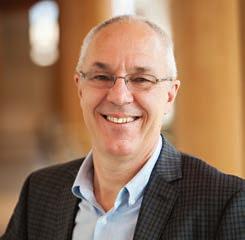
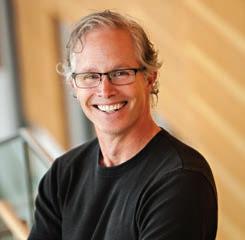


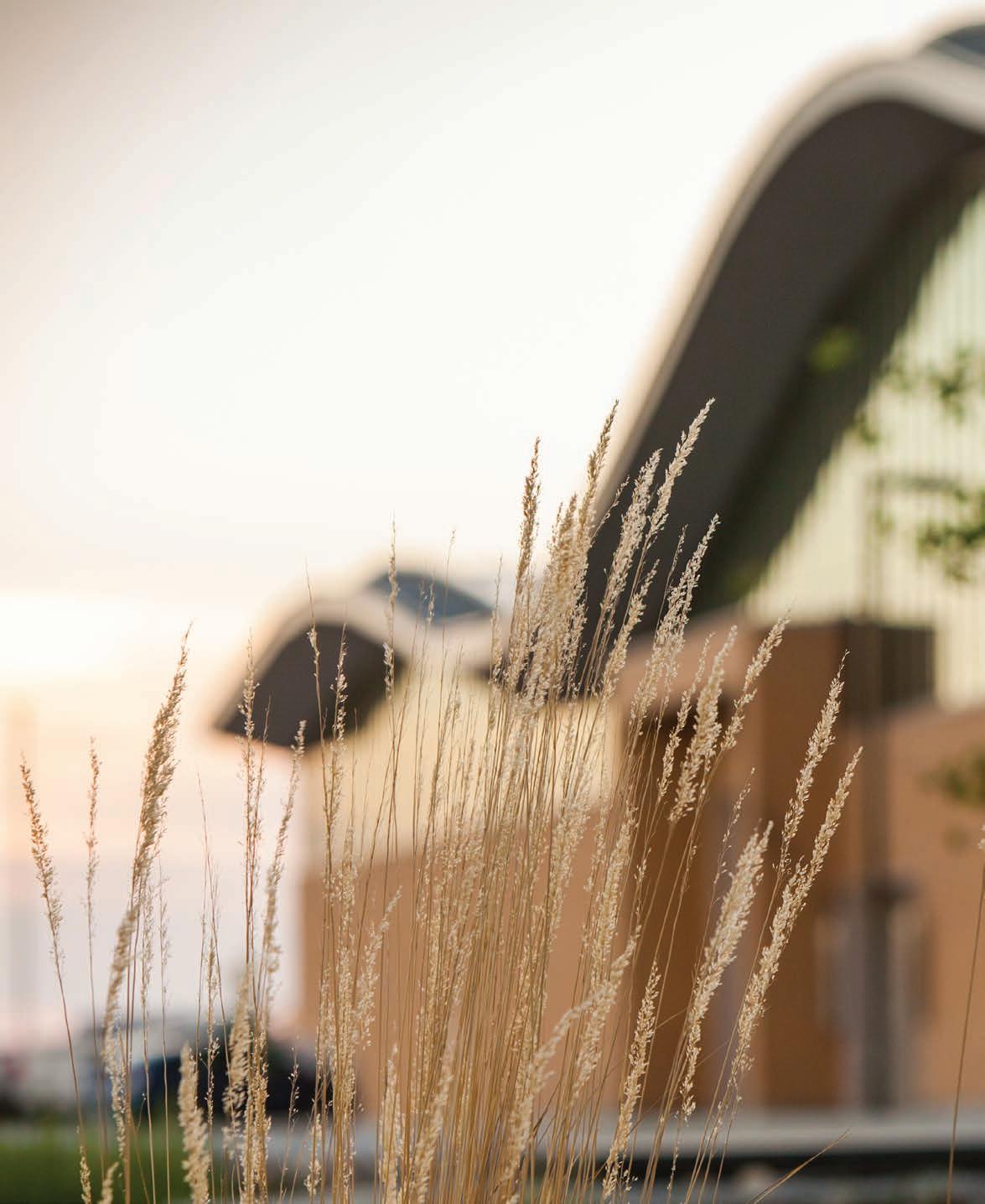
RESEARCH in ACTION
22 | FALL 2018
{ Dr. Kenny Corscadden, associate vice president of research }
Research in action
Applied research may be the bestkept secret at Lethbridge College. But throughout the classrooms, labs, offices and innovation space in nearly every building on this southern Alberta campus, some of the most cutting-edge applied research in the country is taking place.
It can be easy to miss. After all, a visitor can quickly get distracted by the sights of the simulation labs for Nursing students, the sounds of the huge hydraulic lifts for automotive techs in training, and the delicious smells coming from the kitchens where the Culinary students work.
But in between, there are also staff and students focusing on 17 projects in nearly a dozen different areas of research from agriculture to criminal justice to scientific services, funded by the college, the city, the province or the government of Canada. And the projects aren’t just research for research’s sake. Rather “applied research provides pragmatic solutions to real world problems,” says Dr. Kenny Corscadden, Lethbridge College’s associate vice president of research. “It’s a natural fit for colleges and our mandate. It has benefits for students, faculty, community and industry.”
The numbers add up quickly. Between April 1, 2017, and March 31, 2018, a total of 35 instructors, 10 staffers,
19 paid students and 756 student volunteers took part in applied research activities.
“Everyone is surprised at, first of all, how much research we actually undertake here, but also at the type of research that we actually are involved with,” says Corscadden. “For example, it’s quite surprising for a landlocked province to have so much aquaculture research, particularly aquaponics, which is becoming a growth area. It’s not just the amount we do, but the breadth of research that we’ve undertaken.”
If visitors to the college are surprised now, Corscadden suggests this is just the beginning. Ranked 42nd in Research Infosource Inc.’s 2017 listing of Canada’s top research colleges with annual research funding of $1.5 million, he says that number will grow, as will the impact research has on economic growth and industry prosperity in the region.
“A recent study has shown that Lethbridge College contributes about 6.5 per cent to the region’s gross regional product, and I believe we’re well-positioned to transform post-secondary applied research in our region and that would even further drive economic growth,” he says.

Corscadden encourages southern Albertans to watch for more about Lethbridge College applied research, as he looks for ways to create even deeper and wider connections to the community. “This year will see our first student and faculty research symposiums which, of course, we will open to our community so they can see what we actually do here at the college in terms of research.” Until then, to learn more about the applied research landscape at Lethbridge College and some of the projects happening here, just keep reading.

23
Stories by Lisa Kozleski and Dawn Sugimoto | Photos by Rob Olson
“NATURE IS THE BEST ENGINEER.”
{ Dr. Sophie Kernéis }
RESEARCH ROOTED IN ALBERTA’S DIVERSE LANDSCAPE
Microbiology instructor Dr. Sophie Kernéis and agriculture lab technician Leanne DuMontier, with support from a two-year CARIF grant from the Centre for Applied Research and Innovation at Lethbridge College, are collaborating on a project that is meeting the World Health Organization’s request to find new antibiotics to treat infections caused by antibiotic-resistant bacteria. The Antibiotic Alberta Plant Project aims to discover antibiotic molecules from indigenous plants species. Our plant extracts library will be screened for their antibiotic activities and will allow identification of active antibiotic molecules in partnership with pharmaceutical companies or chemists.
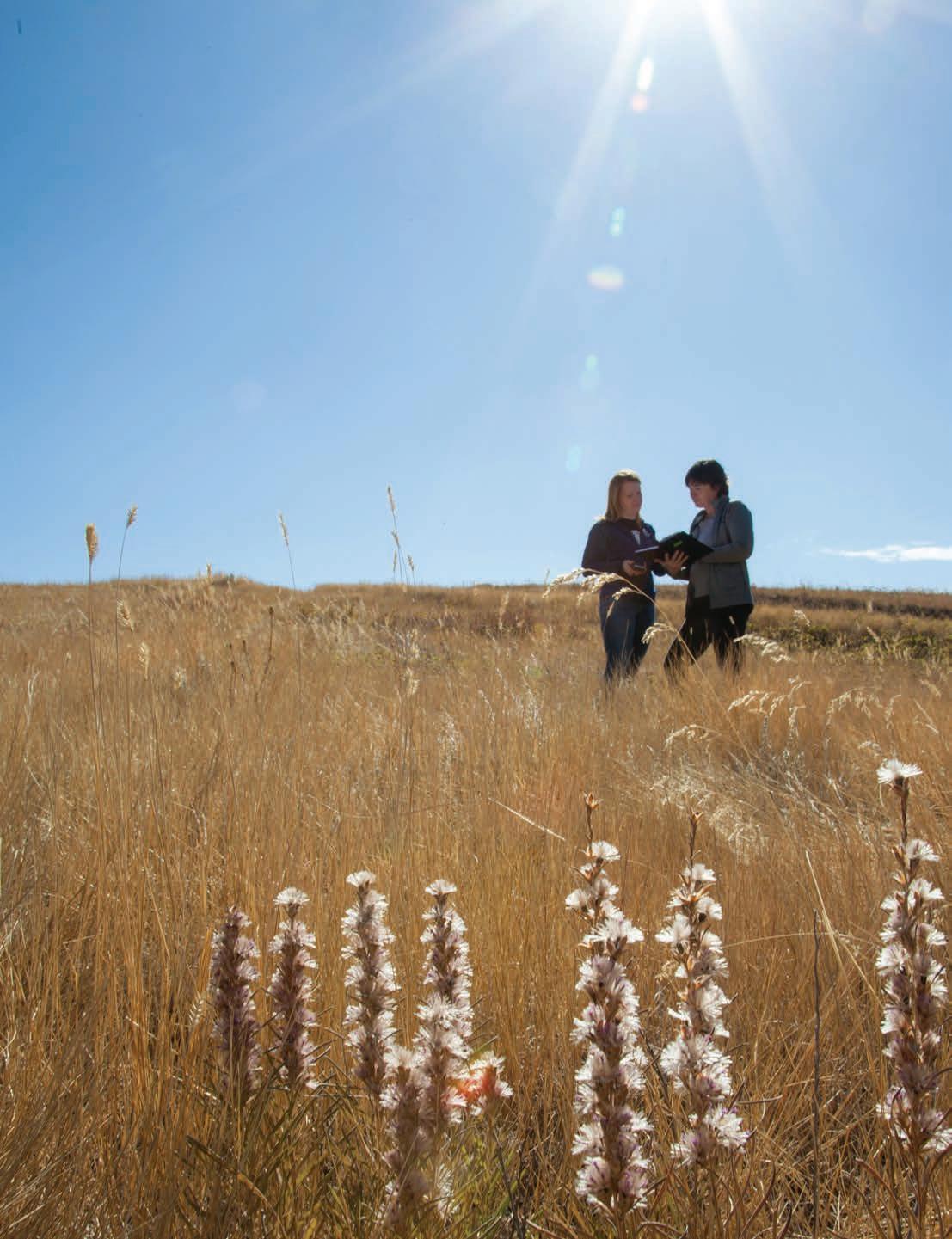
RESEARCH
24 | FALL 2018
in ACTION
Surveying the local landscape
For the last 18 academic years, the Citizen Society Research Lab (CSRL) at Lethbridge College has been doing what it does best – asking
Lethbridgians and Albertans what they think.
For the most part, they did it how they’ve always done it –more than 40 different times since 2001, in fact. During the fall and winter semesters, students enrolled in 19 different courses picked up the phone and asked. They asked about carbon levies and rebates, about off-highway vehicles and camping restrictions, about voting intentions, curbside waste and recycling programs, environmentally sustainable agriculture and more.
But a few things were different this year. Since long-time Lethbridge College instructor Dr. Faron Ellis took on the role of CSRL Research Chair in 2016, the number of students involved in those calls more than doubled – increasing from 198 students in 2015-16 to 427 students this past year – while the number of data collection shifts filled nearly doubled from 274 shifts in 2015-16 to 535 shifts this past year.
And the CSRL tried out a new form of polling this year for a special project with the Lethbridge Police Service. “Lethbridge Police Service Chief Robert A. Davis loves data,” says Ellis. “Rather than holding town halls or using other more conventional feedback mechanisms for its business planning, LPS asked us to conduct an online study of its stakeholders.”
Ellis explains that online surveys are different from the telephone-based opinion polls the students typically work on, as they don’t give everyone in the population an equal chance to respond. Rather, they are built for targeted groups to give
GETTING TO KNOW…
DAVID NAM
If all had gone as planned, David Nam, a 2018 graduate of Lethbridge College’s Computer Information Technology program, would have found a summer job then attended the University of Lethbridge this fall to complete a computer science degree. Instead, he’s contributing to Lethbridge College’s irrigation research efforts, an opportunity supported by the Colleges and Institutes Canada CareerLauncher Internship program. The program provides up to $15,000 to employers to provide six- to 12-month internships for skilled grads in either clean technology or work related to natural resources.

representative feedback from that group. “We ended up with about 1,300 stakeholder email addresses and more than 400 responses,” says Ellis. “The patterns looked good and we were able to verify them in a number of ways.” With such success the first time out, Ellis is looking to work with other organizations who might benefit from this kind of online model. The responses to that first online survey – like the responses to the other 188 reports the CSRL has released since 2001 – can be found on the college’s website (check out learn.lc/csrl).
Initially developed as a way to engage students in his Local Government class in applied research, the CSRL has flourished under Ellis’ leadership to become a nationally-recognized, award-winning quantitative public opinion service provider. Using omnibus surveys conducted by college students each semester, the CSRL measures public opinion on a variety of issues that are of interest to college students, faculty, industry partners and community organizations. It’s made Lethbridge “possibly the most over-surveyed city in the world,” Ellis says with a laugh, adding that he is grateful to the people who take the time to share their opinions with his students.
One project they’ve been working on for two years included questions about Albertans’ use of massage therapy and whether there was support for the establishment of an Alberta college of massage therapists. In the end, the surveys showed great support for the creation of a professional college, and work is now underway to make that happen. The CSRL report and a paper coauthored by Ellis with Rosemary Shannon, Brent Gaudreau and Judy Long now form an integral part of the Massage Therapists Association of Alberta’s submission to the provincial government. “It’s social science applied research in its most pure form,” says Ellis.
While others working with Mueller Applied Research Chair Dr. Willemijn Appels routinely do field work on southern Alberta soil, Nam can be found on campus at his computer. He started by identifying publicly accessible sources of satellite imagery, weather forecasts and other data. Next, he’ll identify ways to collect and process the data to bring images and information together, using Java and Python programming languages.
Nam says he had no real background in agriculture, but he understands the task at hand. Without the program Nam will create, Appels has to visit various sites for geospatial data and use command-line prompts to extract the specific information she needs from the Geospatial Data Abstraction Library. It’s “a painful way to process information,” Nam says.
Appels says Nam’s work will help the team integrate large-scale remote sensing data into projects that now depend on local observations. Eventually, the data could help southern Alberta farmers in their water management decisions.
“I feel extremely lucky and grateful that I have an opportunity to do this internship. Willemijn has been such a great supervisor as well to set all this up.”
25
A project spanning the continent
A Lethbridge College applied research project piloted in 2015 and tested in the coulees behind the college has been adopted by planners and land use specialists overseeing more than 100 open-bottomed- or half-culvert crossings around North America.

Enviro Span, which was designed by Environmental Sciences instructor Ron Hammerstedt and two longtime partners in British Columbia, is an environmentally friendly, modular culvert system that can be used in parks, trails and ecologically sensitive areas. It uses strong, lightweight, adaptable materials that can adjust to the shifts and settling of the earth, and it is both longlived and reusable. Replacing conventional steel arch culverts, these spans protect streams and streambanks and require less time, money, equipment and effort to install.
Hammerstedt and John Derksen, chair of the college’s Aquaculture Centre of Excellence, collaborated on the project with the City of Lethbridge and received support from the National Research Council Canada’s Industrial Research Assistance Program and the Natural Sciences and Engineering Research Council of Canada (NSERC). Together, Hammerstedt, Derksen, city employees and a group of college students worked to install an Enviro-Span culvert across a creek in the Six-Mile Coulee area, along the southern edge of the city. And as part of the project and with support from NSERC, Digital Communications and Media instructor George Gallant and 12 students created five videos documenting each partner’s perspective of the benefits derived from the project.
It was this unprecedented level of collaboration that helped the Enviro Span project stand out among 2,500 projects submitted to the National Research Council’s senior management team to be featured at a presentation in Ottawa in May to the NRC president and more than 50 managers. “To stand out among thousands of Canadian projects is a real testament to the way our Lethbridge region does applied research,” says Cal Koskowich, an NRC industrial technology advisor. “Getting real systems into daily operation and having this example followed internationally shows our tech leadership.”
The way the spans have held up over time has also been encouraging. “One of our colleagues kayaked the length of Six Mile Coulee during the overland flooding this spring,” says Hammerstedt. “Everything was under water. He got to the flood plain near the Enviro Span crossing, and the Enviro Span stayed perfectly where it was supposed to be.”
Since its launch, Enviro Span has been embraced in communities from British Columbia to Florida. To date, more than 100 companies and communities have installed the culvert crossings, and many of those came to the product thanks to the college’s involvement. “We figured out that about 15 per cent of new spans were directly attributable to the college project,” says Hammerstedt. “It really did serve its purpose as an applied research project, finding a solution to a problem facing industry.” The collaboration continues in other ways. Because of the connections made with the City of Lethbridge, Hammerstedt says they are looking at a new research project focused on wildlife connectivity between parks and greenspaces.
“And one of the best little projects that came out of the research was that Amy Russell, one of the students who had worked on the project, followed up and used it for her senior project,” Hammerstedt says. “She was then invited to present her results to Trout Unlimited at their general meeting, and after seeing it, they and the Nature Conservancy called a distributor and said they wanted to use it to rehab a stream to support West Slope Cutthroat Trout, which are a listed species.”
To get to their pastures, livestock had been walking through little streams and creeks that were home to the trout, ruining the waterways. By installing Enviro Span and adding a bit of fencing, they could cover the waterways and direct cattle to cross there, saving the streams from damage. “They erected it about a year ago and it’s been functioning well and they’re happy with it,” Hammerstedt said. “The cows are too – cows actually don’t like getting their hooves wet, so everyone’s winning, including the cows. But the coolest piece is that a student generated the research and actually got Trout Unlimited and the Nature Conservancy to try it out –and it’s working.”
RESEARCH in ACTION 26 | FALL 2018
“SO EVERYONE’S WINNING, INCLUDING THE COWS.”
{ Ron Hammerstedt, Environmental Sciences instructor }
GETTING TO KNOW…
DR. KENNY CORSCADDEN
He’s only been part of the Lethbridge College team for a year, but he’s proven a quick and natural fit with the institution’s growing profile in applied research. Dr. Kenny Corscadden came to the college as dean of the Centre for Technology, Environment and Design and within eight months, he was named Associate Vice President of Research, putting him in the driver’s seat of research efforts across campus.
Corscadden came to Lethbridge from Dalhousie University in Halifax, where he was associate dean of research and graduate students in the Faculty of Agriculture. He had previously served as head of the Department of


Engineering and as an industry research chair at Dalhousie, and had served as an engineering instructor at neighbouring Acadia University.
Even before joining academia, Corscadden was involved in research in the private sector with businesses specializing in manufacturing, commercialization, engineering and product development. He started his career as a ground radar technician in the Royal Air Force in the United Kingdom, leading to a variety of technical and entrepreneurial roles, which he managed while continuing his education.
With a career spanning both sides of the Atlantic, he seems to have mastered the art of the move. The father of four says he enjoys renovating homes, and his Lethbridge abode is No. 21 and “my wife says this is the very last one,” he says with a smile.
The constant in his career has been witnessing the impact applied research can
PLAY IS THE PRIORITY
Lethbridge College is going back to basics for its outdoor play space. Located in the heart of the college’s campus, the current yard is being converted to a state-of-the-art outdoor play environment. After a ceremonial ground-breaking in April, work started this summer, with completion expected later this fall. The newly renovated area will support recent research around the development of children in the areas of outdoor, risky and loose parts play. The space is used by the Hands-On Early Learning Centre, which provides daycare services to children of college students and some staff members,
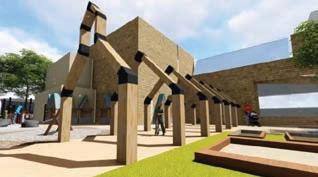

and it will be tied to curriculum in the Early Childhood Education program. Twelve community partners from the construction industry are donating time, supplies and expertise to create the play area. They include Caliber Landscaping; the City of Lethbridge; D.A. Electric; Irritech Sprinkler Systems; KB Heating and Air Conditioning; Lafarge; McNally Contractors; Operation Underground Railroad; Scenic Drive Landscape Centre; Site One Landscape Supply; Southern Excavating; and Whissell Contracting.
have on students, industry and a learning community. “It provides students with experiential learning,” he says, making it a natural fit with a hands-on institution like Lethbridge College. “It gives faculty a chance to keep relevant in their discipline areas and to apply their expertise and help industry become more competitive.”
Illustrations by Brittany Gilcrest (Interior Design Technology 2018)
27
Bringing the farm indoors
In this industrial-looking space, there’s little sunshine, no wind aside from the building’s ventilation system and not a gopher hole to be found. But there are tonnes of southern Alberta top soil and tender growth of one of the province’s most common crops, alfalfa – all of which are essential aspects of research that could change the way crops are grown around the world.
From the Innovation Space in the year-old Trades, Technologies and Innovation Facility, Appels, a hydrologist and soil physicist, is creating an almost perfectly controlled environment for her research on subsurface drip irrigation (SDI). Work began in January to construct three raised, three-by-six-metre beds nearly a metre deep. Each is filled with top soil donated from farmers — Grassy Lake sand, Lomond loam and Coaldale clay. Appels and industry partner Southern Irrigation designed the wooden boxes, which college staff built. Plexiglas sections offer a side view of the soil, roots and moisture.
Appels and her team are studying subsurface drip irrigation to deliver water and, eventually, nutrients directly to the alfalfa’s root zone and to understand how the water moves in different soil types. The one-year research project has support from Southern Irrigation, and funding from a $50,000 Natural Sciences and Engineering Research Council of Canada (NSERC) Applied Research and Development grant, and another $20,000 from the Regional Innovation Network of Southern Alberta. Bringing the farm indoors gives Appels control over weather, pests and other variables. She can work year-round and can push her crops to extremes, something she can’t do in a field with a farm’s prosperity hanging in the balance. While SDI is relatively new to southern Alberta, it has existed for decades in countries with water scarcity, and its main benefit is efficiency.
But because SDI happens entirely out of sight, it can feel like a leap of faith for farmers who are accustomed to seeing pivots deliver water in an obvious spray. That’s why Appels’ research is so important, says Marc Jongerden, installation manager with Southern Irrigation, the college’s partner in this endeavour. “This (research) is teaching and training growers to really know their soils and how their soils work with a totally different way of irrigation,” he says.
Appels notes that farmers who adopt SDI will have a learning curve, but she hopes her work helps. “The more complex the irrigation system, the more complex the water management,” says Appels, who is entering her third year as Lethbridge College’s Mueller Applied Research Chair in Irrigation Science, a position made possible by a $3.1-million gift from Lloyd and Dorothy Mueller.
Doug Stanko, who donated the soil labelled “Lomond loam,” has a reputation as an early adopter of new methods, and he has subsurface irrigation on part of his land. When he was approached about donating some of his soil, he was briefed on the research project, but that still didn’t prepare him for what he saw when he first visited the college. “I was so impressed,” Stanko says. “This is a really good idea.’ ” He says the idea of SDI made sense intuitively because it focuses water where it’s needed and it encourages deeper root growth, away from potential heat stress.
Stanko says he also appreciated Appels’ approachable manner — she talks with and listens to farmers about their needs and issues. That was also Jongerden’s experience. In Appels and Lethbridge College, the irrigation company found an open partner interested in improving the practice of farming. “We believe in this and we know this will be one of the systems for the future,” Jongerden says. “We believe in it for water usage, to spread the water more efficiently and to open up more acres.”
A BIG FIRST FOR LETHBRIDGE COLLEGE
Lethbridge College has received its first institutional grant funding from the Social Sciences and Humanities Research Council (SSHRC), a relative rarity for colleges. Over the past three years, only 10 Colleges and Institutes Canada members have received SSHRC institutional grant funding.
Lethbridge College’s SSHRC grant will provide $45,000 over three years to support
small-scale research and related activities. Faculty will be invited to submit applications which will be evaluated through a peer review process. “They are keen for colleges to participate and we have the capacity to undertake social science research,” says Dr. Kenny Corscadden, Lethbridge College’s associate vice president of research. The SSHRC institutional grant will provide the
college $45,000 over three years to support small-scale research and related activities.

Corscadden says he expects these small grants – potentially five, $3,000 awards per year –will create more opportunities for students by providing for pilot projects or work that will be foundational to larger research efforts.
Corscadden expects the application process will be open in September 2018.
From the climate-controlled confines of Lethbridge College’s newest building, Dr. Willemijn Appels has a window into a normally hidden world of soil and water.
RESEARCH in ACTION
28 | FALL 2018
GETTING TO KNOW…. JESSICA SNOEK
Lethbridge College’s irrigation research team enjoyed an extra set of hands this summer, when Jessica Snoek was on campus conducting her master’s thesis research.
Born and raised in Amsterdam and studying at nearby Wageningen University, the 23-year-old asked her favourite professor where she might pursue her research. She was referred to Dr. Willemijn Appels, Lethbridge College’s Mueller Applied Research Chair in Irrigation Science. Appels had also studied at Wageningen, her work fit Snoek’s area of interest and the opportunity brought her to Canada, a country on her wish list to visit.
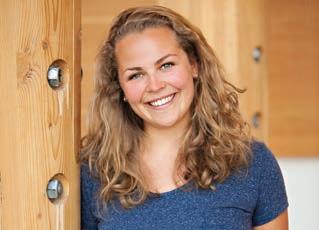
Snoek’s efforts are focused on a particularly challenging piece of farmland near Coalhurst. “It has a 50-metre elevation difference in the field,” she says. “It has three different soil types. It has a little pond on the field that’s wet the entire year. It’s so interesting for us.” Working closely with the owner’s crop consultant, researchers have shared data collected by a computer-controlled drone, capable of capturing thousands of images of multiple reflectances such as infrared and near-infrared data. Conditions are also monitored through on-site soil moisture sensors, groundwater level loggers and a weather station. The data is processed through a computer crop modelling program to compare outcomes predicted by the model with conditions measured in the field. The goal is to better predict actions the farmer can take to increase land productivity.
Snoek, who was on campus from late March through July, says providing research-driven solutions to help people use land more sustainably is what she enjoys most about her work. “That, for me, was the most important combination, not only being indoors in the lab looking at numbers rolling out on the computer but actually seeing it in the field,” she says. “It gives the farmer an enormous amount of insight.”
“IT’S NOT JUST RESEARCH IN A LAB.
IT’S SOMETHING OF PRACTICAL VALUE.”
{ Marc Jongerden, installation manager with Southern Irrigation }
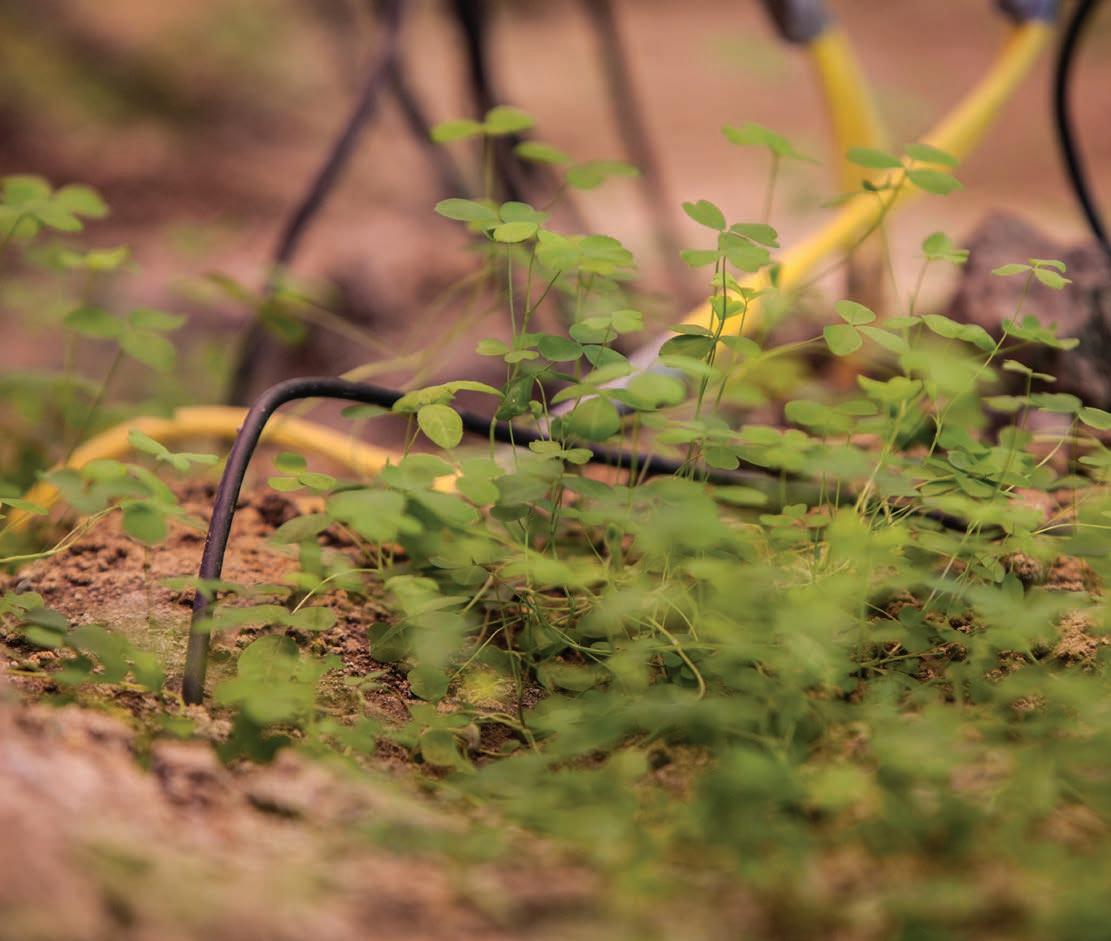
29
GETTING TO KNOW…
An eye on feeding an increasingly hungry world
and is bringing biochar to market as a growing medium. Driving his entrepreneurial efforts is an understanding of the precarious nature of food security – subject to the possibility of trade wars – and a burgeoning global population.
But biochar, a fine-grained, highly porous charcoal that is the focus of new research by the college’s Dr. Nick Savidov, could prove to be an effective option for micro-nanofiltration in aquaponics – and that could end up being a small-butmighty game changer in the production of a sustainable model of agriculture.
There are a few things that make this horticulture-grade bamboo that has been converted to charcoal through a process called pyrolysis so remarkable. Biochar – particles that are one to three millimetres long – is highly stable, retains its shape over time even in water, and is highly porous, creating a massive surface area in a compact package.
“Just one gram of biochar has a total surface area of 250 to 300 metres square, or more than 3,000 square feet,” says Savidov, an internationally recognized aquaponics expert and researcher working at the college’s ACE facility. “That’s a surface area larger than a standard doubles tennis court.”
Savidov is testing various amounts of biochar for its ability to capture micro- and nano-particles to improve water quality for both plants and fish, and to see whether it also creates beneficial microflora that can contribute to cleaning water. This year-long, $50,000 research project was made possible with equal support from the Natural Sciences and Engineering Research Council of Canada (NSERC) Engage grant program and Alberta Innovates’ Campus Alberta Small Business Engagement Program. Critical to the work is the industry partner, which is officially know as 1722497 Alberta Ltd. and operates greenhouses in southern Alberta.
Daniel Ronald is the co-founder and chief technology officer of Pure Life Global, which recently acquired 1722497 Alberta Ltd.
He also sees the practical need for this research. The company created its own design for vertical growing towers to maximize use of greenhouse space in an aquaponics setting. Water containing fish effluent provides nutrition to the plants, which clean the water for the fish habitat. However, solids in the water were clogging the roots of plants in the vertical towers. With the support of the grants, Savidov and team have the resources to design 20 “mini-systems” to test various amounts of biochar for its ability to capture micro- and nanoparticles to unclog the system and improve water quality for both plants and fish. Researcher Dr. Zied Khiari conducts the analysis of particle size and water quality on the project.

Ronald says he’s excited to see the results and how this work will advance his goal of “a high quality, sustainable food security model that doesn’t rely on herbicides or genetically modified organisms to solve the food gap that’s coming. It’s foolish to think the existing model of agriculture can continue,” he says.
The project has potential applications for waste management, closed-loop production systems like aquaponics, irrigation water treatment and food production. Biochar can be used year after year, and it does not need to be replaced because it retains its shape and porosity over time. “Zero waste agriculture is the main goal, and this would have potential to treat grey water in animal husbandry, waste management and municipal water treatment,” Savidov says. “It even has potential to remove pathogenic bacteria to produce potable water.”
All of that – something that could change the way food is grown and one day feed a hungry world – is found in the college’s ACE facility, in an amount so small it fits easily in Savidov’s hand.
It doesn’t look like much. It blows around on even the slightest draft in the Lethbridge College Aquaculture Centre of Excellence (ACE)
RESEARCH in ACTION 30 | FALL 2018
“JUST ONE GRAM OF BIOCHAR … HAS A SURFACE AREA LARGER THAN A STANDARD DOUBLES TENNIS COURT.”
 { Dr. Nick Savidov, senior research scientist at Lethbridge College }
{ Dr. Nick Savidov, senior research scientist at Lethbridge College }
GETTING TO KNOW…
JOHN DERKSEN
John Derksen spends his work days the way he’d choose to spend any day, given the choice – dealing with fish. “I’ve just followed
my passion,” says the chair of Lethbridge College’s Aquaculture Centre of Excellence (ACE) facility. “I’ve always loved fishing. When I go on vacation, I’m always going fishing. And after I finished my studies, I wanted a job that had anything to do with fish.”
Derksen found that job at Lethbridge College in 1997. After earning both his Bachelor and his Master of Science degrees from the University of Guelph, he heard about the opening in southern Alberta, which was just about to build the new ACE facility. He stepped in as a teacher and now also leads and manages research projects and collaborates with other researchers on campus.

“I wanted the job to be dynamic and research offers a big part of that,” he says. “The diversity of research is kind of nice, too. I can bring it to the classroom and I can involve students on the projects as well.
It keeps me busy in the summer but I love it. It’s like you get to play when you’re working.” He says that applied research opportunities at Lethbridge College are a hidden gem. “It does surprise a lot of people, the research that goes on here and the opportunity students have to take part it in,” he says. “A university might work on solving a theoretical problem, which is important, but the college is working more directly with the industry to solve real problems.”
Although the opportunity to retire could come knocking in the next few years, Derksen says he’s not tempted by it. “It’s exciting to think of continuing our research and seeing how the college can develop and how ACE can develop as a centre. The people I work with at ACE are awesome and Kenny (Corscadden, the college’s new associate vice president of research) is amazing. I still grin when I come into work – I get paid for this!”
TAKING THE SHOW ON THE ROAD
In the year ahead, Lethbridge College is looking to take its aquaponics expertise on the road and share it with Alberta children and their families who visit the new Granary Road Active Learning Park south of Calgary. The park, which provide 36 acres of activities, 3.5 kilometres of trails, a petting zoo and almost a dozen themed exhibits, could be an ideal setting for an aquaponics display, says Dr. Jagvir Singh, director of Applied Research and Innovation. “It would provide a visual treat to the visitors who would be able to get a glimpse of the unique ecosystem
of aquaponics world, demonstrating the power of the microbial world in converting fish waste to nutrient solution.” The park opened in the summer of 2017 and the design of the learning pavilions, which are aimed at children from kindergarten to Grade 9, was overseen by Calgary teachers to ensure it aligns with Alberta educational curriculum. The park is located on 112th Street West and south of Highway 22X and also includes a farmer’s market, bakery, green house, food vendors and more.
31
{ Chef Doug Overes }
SNAPPER VERACRUZ
Sometimes, all it takes is a few simple ingredients to create a masterpiece. That is the case with this recipe, which was named after the port city of Veracruz, Mexico. Snapper Veracruz has been called the signature dish of the state of Veracruz, and it combines ingredients and cooking methods from Spain and pre-colonial Mexico. It’s a classic dish that is easy to prepare and so full of flavour.

C hef Doug Overes (Professional Cooking 1987; Distinguished Alumnus 1992) suggests that if you want to enhance the taste even more, you can grill your fish slightly on a lightly oiled barbeque for a few minutes and then set it aside and return it to the pan when indicated in the recipe. This leaves it smoky and delicious. And while he says snapper is available fresh year round in Lethbridge, cooks are welcome to try any other firm, white-fleshed fish. He suggests serving it with a great, fresh rose, herby Sauvignon Blanc or an Italian red.
To sample some of the delicious creations from student chefs at Lethbridge College, book a table in the Garden Court Dining Room, by calling 403-320-3230. And to see a video of this recipe being prepared by Chef Doug, go to widerhorizons.ca.
From our kitchens
32 | FALL 2018
Recipe by Chef Doug Overes | Photo by Rob Olson
HUACHINANGO A LA VERACRUZANA
Ingredients
2 tbsp. canola oil
4 ........................................... boneless, skinless red snapper fillets
1 c. chopped onion
4 garlic cloves, minced
1 can (28 fl. oz. or 796 mL) chopped Italian plum tomatoes

2 limes, juice and zest
1 tsp. chili powder
¼ c. chopped cilantro
1/3 c. ....................................... sliced, pimento-stuffed green olives
To taste cracked black pepper and salt (if not using the olives)
Method
1. Heat the oil in a skillet until very hot (or on a grill as Chef Doug suggests).
2. Add the fish and sauté on both sides for about 1 to 2 minutes until brown. Do not overcook.
3. Remove from heat and set aside.
4. Add the onions and garlic until the onions are softened slightly.
5. Add the remaining ingredients, except for the cilantro and olives, and simmer for 10 minutes to reduce slightly.
6. Add the olives and cilantro and return the fish to the sauce.
7. Cook until the fish is rewarmed and cooked through. Season to taste.
8. Makes two large or four small portions. Enjoy!
{ { 33
{ Office Intrigue } Humboldt strong
M ore than 200 staff members – and even the children from the college daycare – joined communities across Canada in marking Jersey Day on April 12. The event was an organized effort to recognize and honour the 16 people killed and 13 injured in the crash of a coach
bus carrying the Humboldt Broncos junior hockey team and their staff to a playoff game on April 6 in Nipawan, Sask. Lethbridge’s Logan Boulet, who had played for the Broncos for parts of three seasons, was among those killed in the crash.
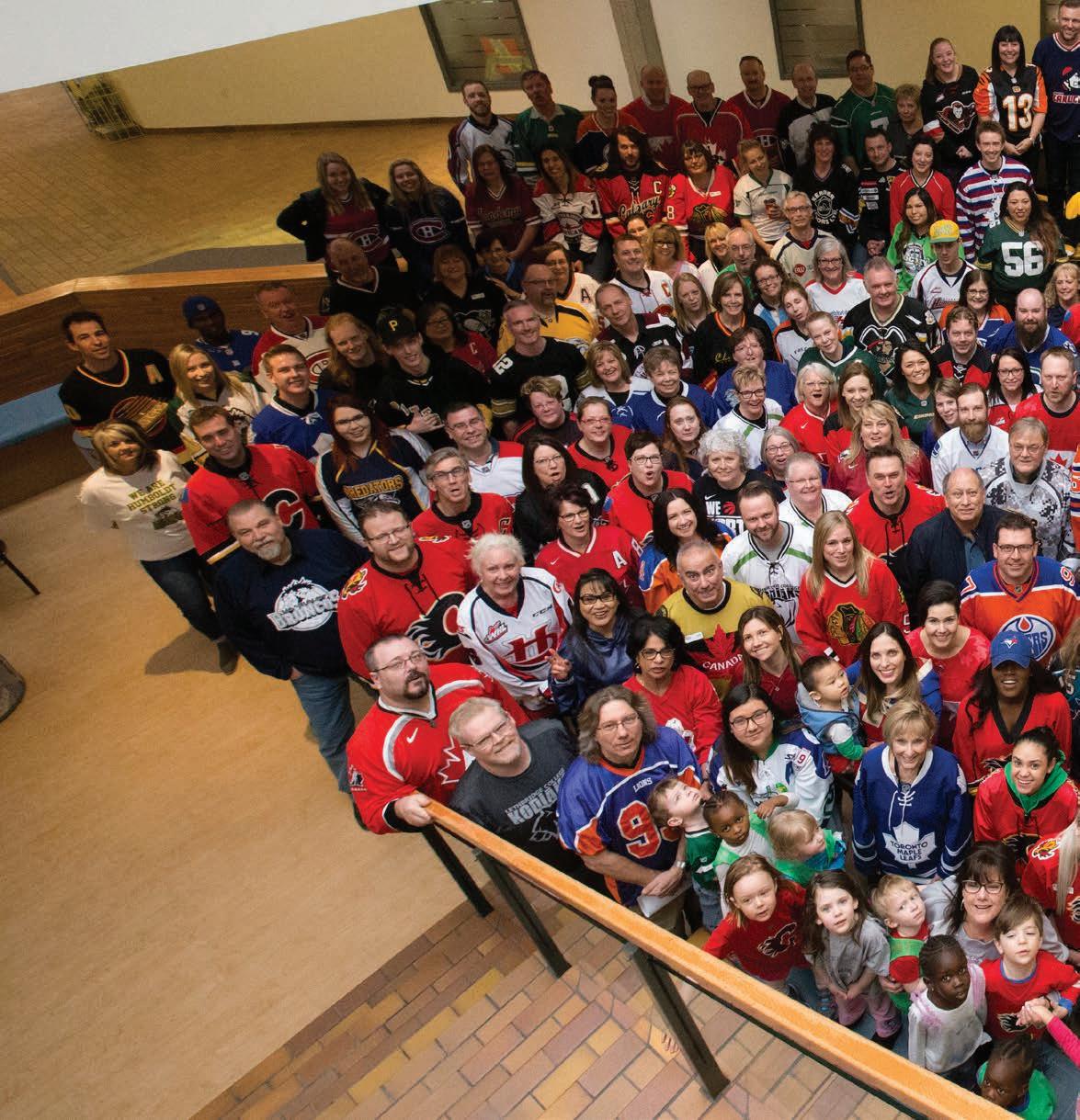
Office intrigue
34 | FALL 2018
Staff members generously shared extra jerseys with those who didn’t have them to prepare for this photo in Centre Core, and many, including those with ties to the Humboldt team, donned the green and gold. As a way to commemorate the day and to honour the team and their families and fans,
Wider Horizons is temporarily abandoning our usual “Office Intrigue” format to showcase the best of office life – when colleagues come together to honour, grieve, celebrate and remember.
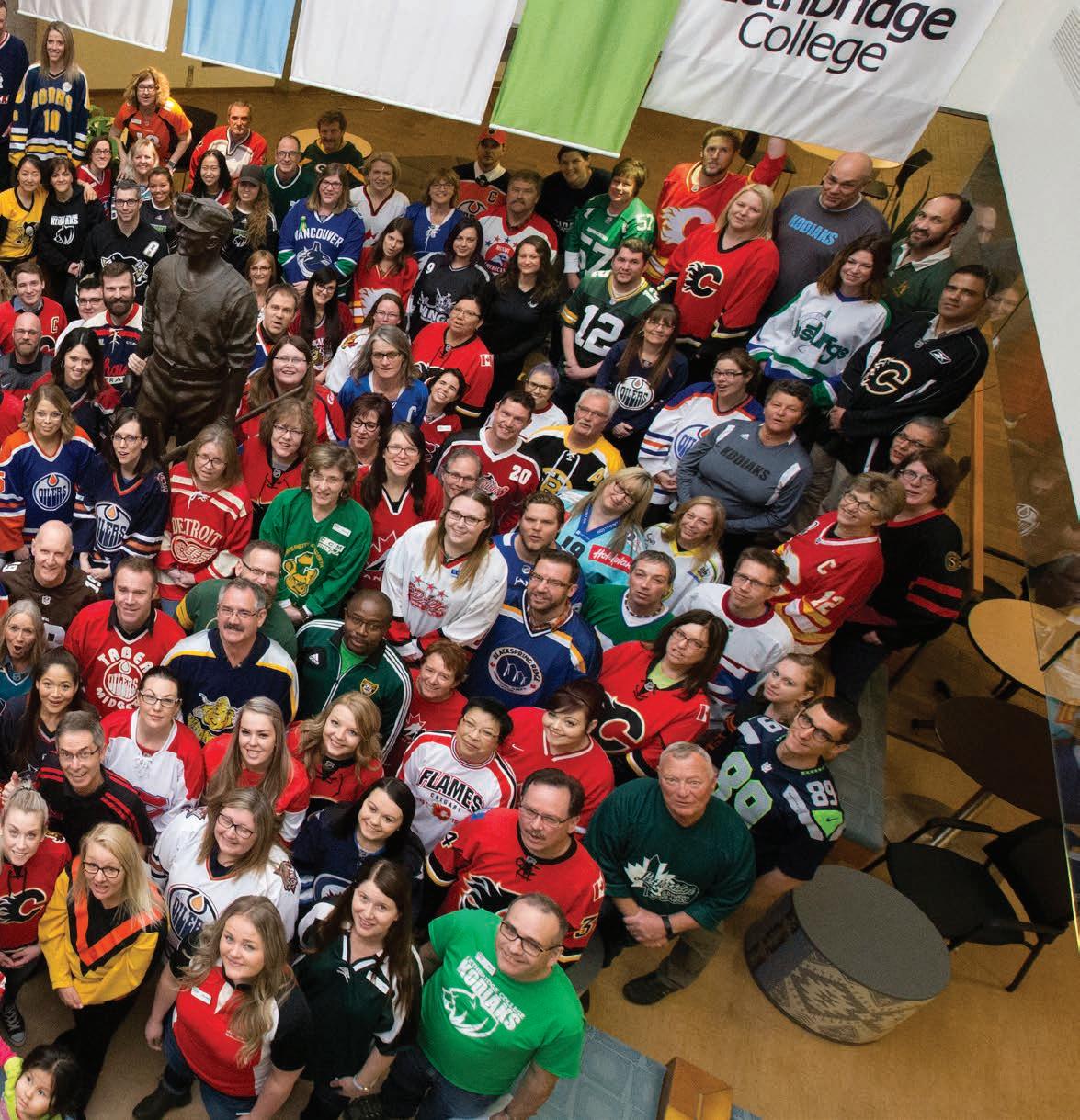
35
Story by Lisa Kozleski | Photo by Gregory Thiessen
changing with
 Dayne Adam, a 2018 Multimedia Production graduate used extended reality – or XR – to create his second-year capstone project.
Dayne Adam, a 2018 Multimedia Production graduate used extended reality – or XR – to create his second-year capstone project.
36 | FALL 2018
mindsets headsets mindsets
Virtual learning opens real doors at Lethbridge College
Anew teaching tool at Lethbridge College is creating opportunities and connecting students in profound ways. For some, it takes them to the top of a gusty wind turbine tower. For others, it sweeps them away to the scene of a horrific car crash where they have to put the skills they’ve learned in the classroom – whether as an emergency responder, a police officer or a member of the media – to the test. Still others use it to immerse themselves and their clients into the house of their dreams, showcasing the details and design touches that distinguish their work.

37
it’s a tool that sounded like science fiction just a generation ago (although it was starting to be used for training and simulations even back then). But today, at Lethbridge College, students can put on a headset and step into a new world – the world of augmented, virtual, mixed and extended reality (also known as AR, VR, MR and XR). They can acquire experiences that typically would take years and countless miles to accumulate, and apply it to the lessons they are learning in the classroom.
Whether they are taking in the view from the top of Mount Everest or standing on the edge of a high-rise with a virtual welder in their hands, they are benefitting from the best technology has to offer while acquiring skills that will help them stand out as they enter the workforce. It’s a tool as transformative as the telephone and as quickly evolving as the World Wide Web.
It’s changing the way Lethbridge College instructors teach. “Extended reality brings teaching to life,” says Kris Hodgson, chair of the college’s School of Media and Design and an instructor in the college’s Digital Communications and Media program. “How else can you understand how an earthquake affected a community without actually standing on the ground where the tragedy hit? XR brings you anywhere you want to go in the world, and as it does, it creates greater empathy and a better understanding of global events.”
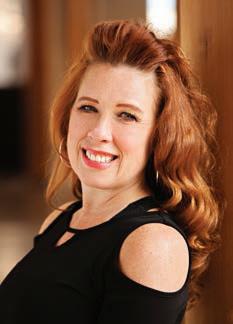
And it’s changing the way Lethbridge College students learn. “It’s not just games,” says Dayne Adam (Multimedia Production 2018), a recent graduate who used XR to create his second year capstone project. “The potential is limitless for learning as well as for entertainment. With XR you will be able to first create scenarios for yourself before trying them for real. This could be huge for many industries from machining to first responders and healthcare professionals to architects and engineers. Interacting with a 3D model in 3D space is revolutionizing the way that we learn.”
L istening to people in the extended reality community talk about their topic is an exercise in understanding acronyms. Detailed definitions can be found on p. 39, but think of XR – extended reality – as the umbrella term that covers all realities (augmented, virtual, mixed and 360-degree video and storytelling) together. The one most used at Lethbridge College is VR, which is a mosaic of technologies using virtual reality headsets to generate immersion using realistic sounds, images and other sensations that replicate a real environment or create an imaginary world.
XR is already a big deal – in economic as well as technological terms. Recent market research from the International Data Corp. forecasts worldwide spending on XR products and services in 2018 will reach $27 billion, which is a 92 per cent increase over 2017. And that market could grow to a $108 billion market by 2021, according to DigiCapital, a company that advises AR/VR and game leaders around the world. And studies by Research and Markets in Dublin, Ireland, show that in the next five years, revenues in VR alone are expected to grow by at least 54 per cent.
This technology already has a significant foothold in Alberta. The XR industry in the region includes 103 private sector companies, including 40 game developers, 18 working on 360-video and storytelling, 21 dedicated to VR/AR development, six specializing in VR-focused real estate and five working on VR film development. In the Lethbridge area, the emerging information and culture industry, which includes XR/ VR, showed the highest sector growth rate and an employment growth rate of 236 per cent, according to a 2017 report from Economic Development Lethbridge, 2017.
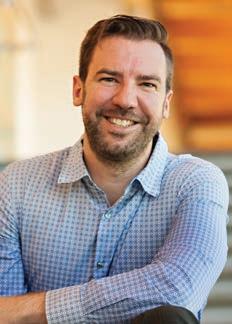
This rapid growth rate is due in part to the network of support provided by the City of Lethbridge, Economic Development Lethbridge, the Regional Innovation Network of Southern Alberta, and the college. In fact, two XR/VR focused companies, Output Media and Neospatial, were incubated and launched in Lethbridge with support from this network.
These numbers are only expected to grow in the decade ahead as technology improves and more and more people and businesses adopt it. And faculty and staff at Lethbridge College have embraced the role of early adopters and are working to be leaders in this young and growing industry. Currently, there are eight program areas where staff members are using or developing 360-degree storytelling or augmented, virtual or
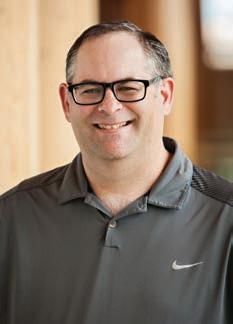
38 | FALL 2018
Lethbridge College instructors (from left) Kris Hodgson, Mike McCready and Cherie Reitzel have integrated AR, VR, XR and/or 360 into the curriculum of the classes they teach.
extended reality experiences in the classroom. Among the leaders on campus are Hodgson and his fellow Digital Media and Communications instructors Pete Gingras and George Gallant; Multimedia Production instructor Mike McCready; and Interior Design Technology instructor Cherie Reitzel.
McCready says his program area is a natural fit for XR, as it prepares students to create content and experiences that incorporate a variety of media, including video, 3D, animations, graphics and more. “XR is the epitome of multimedia,” he says. “A compelling XR experience uses all of these media formats and more. It’s important that we properly prepare our students for cutting-edge technologies – including XR.”
For Reitzel, XR allows her students to immerse themselves (and their clients) in the spaces they’ve designed to help visualize the finished products. After seeing their designs come to life in XR, “students feel as though their designs have been experienced. For us, this is the greatest in experiential learning on the market.” And it is an experience and knowledge that benefits students as they launch their careers and the college as it distinguishes itself from other post-secondary institutions around the country.
XR is also used for 360-degree storytelling by students of Hodgson, Gingras and Gallant, instructors in Digital Communications and Media who specialize in video production and filmmaking, including 360-degree video production use. This last semester, DCM students quickly learned that 360 works well for feature stories and taking a viewer to a new place to experience a story – but it doesn’t work as well for breaking news. “It immerses the viewer in a different environment, and it gives you a view you couldn’t get with just a picture or traditional video format,” Hodgson explains.
ar, vr, xr, 360… what’s the difference?
AR – or augmented reality – uses technology to create an enhanced version of reality.
• AR creates an overlay of virtual content, but can’t interact with the environment.
• When you use AR, you are still seeing the real world, but with extras added. (Think of Pokémon GO or special Snapchat filters like the ones the college uses for Convocation or special events.)
• You can experience it using your cell phone and use it to explore the world around you.
VR – or virtual reality – uses technology to create a simulated environment.
• VR immerses you into a completely virtual environment.
• That virtual world can be artificial (an animated video game) or an actual place that has been photographed (the top of a wind turbine or in the middle of a herd of cattle).
• VR requires closed visors or goggles to block out the room and virtually take you somewhere else. You can move around and look in every direction and explore places you have never been.
XR – or extended reality – is a far-reaching, inclusive and flexible term that brings both AR and VR realities together.
• The “X” represents a variable that is not fully known, intentionally suggesting an open ecosystem that will continue to expand.
• XR encompasses the entire spectrum from real to virtual, and is a still-evolving industry.
360 – or 360-degree storytelling – is a new and immersive approach to one of the oldest learning models around: telling stories.
• 360-degree video is live footage collected from a real-life event or place that can transport you to the middle of where a story is taking place.
• It is similar to video you would watch on your TV, except you can now experience it as if you were in the middle the story, and not standing on the outside looking in.
“Extended reality brings teaching to life. XR brings you anywhere you want to go in the world, and as it does, it creates greater empathy and a better understanding of global events.”
{ Kris Hodgson }
39
One story that worked particularly well was a feature on the Lethbridge Therapeutic Riding Association. “The students took a 360-camera and put it in the middle of a horse enclosure, and at one point, a horse walked up and put its mouth on the camera,” Hodgson recalls. “It gave a view of it you could never get with just a picture or traditional video format. You saw what you would see if you were sitting in the middle of a pasture.”
As a tool for journalists, 360-degree storytelling can be truly life-changing. “It provides the freedom to look anywhere you’d like,” says Hodgson. “With 360, you can experience what it is like in the middle of a Syrian refugee camp, which can lead to greater compassion and greater empathy as you are truly putting yourself in someone else’s shoes.”
With expertise and dedication coming from across campus, college instructors and students organized what ended up being the world’s first full-day VR/AR conference held entirely in virtual reality on April 26. Students planned the Merging Realities: An Event of Multiple Perspectives event, which featured speakers from the VR/AR industry in Alberta and abroad. The event garnered the support of a variety of partners, including the Virtual Reality Augmented Reality Association, the Natural Sciences and Engineering Research Council of Canada, the Regional Innovation Network of Southern Alberta, the college’s School of Media and Design, and industry partners from across the province and the globe.
The event kicked off with a virtual welcome from Alberta’s Minister of Advanced Education Marlin Schmidt. “I was very pleased to be able to participate in Lethbridge College’s Merging Realities conference and to see the innovative ways the college is on the cutting edge of these exciting new technologies,” he says. “Our government is working with the post-secondary education sector and industry to make sure we are expanding the number of high technology opportunities for students as we work to strengthen and diversify the economy.”
He also got a thrill out of using a virtual reality headset and technology to communicate with the participants at the event – and he’s not alone in enjoying the XR experience. The first time Dayne Adam put on the goggles and stepped into another world, “it blew my mind. I had never seen anything like it, and I immediately knew that I wanted to be involved with it in some way.” Sarah Westfall (Interior Design Technology 2018) also loved it. “Everything appeared so real and it didn’t take long to forget that I was sitting on a chair in the classroom.”
But Stephanie Savage (Digital Communications and Media 2018) had the opposite reaction. “I hated it,” she says. “It was such a departure from what I had done previously and the tech really does take some getting used to. After a while it got easier, but man, the first couple of times were tough. There is a definite learning curve when using this new technology.”

40 | FALL 2018
Stephanie Savage, a 2018 Digital Communications and Media graduate, spoke about best practices in 360-degree journalism at the Alberta Weekly Newspapers Association symposium.
merging realities
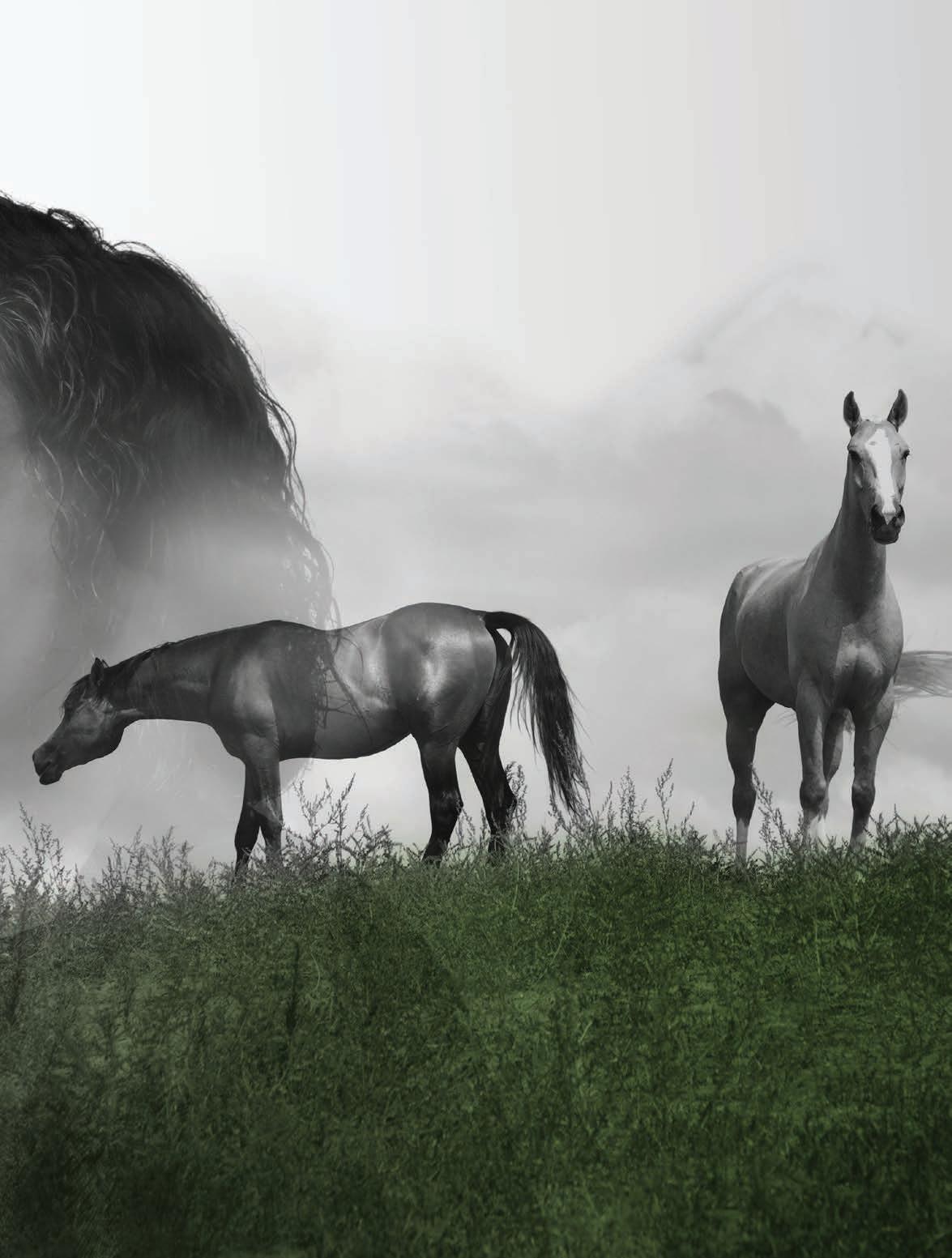
On April 26, Lethbridge College hosted Merging Realities, the college’s (and world’s) first full-day conference held entirely in virtual reality. The event exceeded everyone’s expectations, with participants coming online or in-person from:
• 5 continents
• 16 countries
• 84 cities
Additionally, the event prompted:
• 712 live views and a total of 12,690 minutes watched on the live streaming video platform, Twitch
• 1,509 unique visits to the Merging Realities webpage
• 2,957,726 impressions of the #mergingrealities2018 hashtag
“Merging Realities was the beginning of something truly transformative. Presenting a keynote to hundreds of people around the world with all types of media – slides, audio, video and 3D models in VR – without having to take one flight is a game changer!”
41
{ Alan Smithson, CEO, MetaVRse }
lc leading the way in xr
Students and staff are leading the way in the quickly evolving XR industry. Highlights include:
• Kris Hodgson, chair of Media and Design, who presented Best practices in 360-degree journalism at the Radio Television Digital News Association national conference and awards gala in May.
• Multimedia Production instructor Mike McCready, who was named chapter president of the Alberta chapter of the VR/AR Association (VRARA). He was also invited to speak at VRARA’s Global Summit in Vancouver in September.
• Cherie Reitzel, Interior Design Technology instructor, who was a sponsor exhibitor at the Art of Leadership for Women in Calgary in June and presented on VR.
• Recent Digital Communications and Media grad Stephanie Savage, who discussed the best practices for 360-degree journalism at the Alberta Weekly Newspapers Association symposium in early June.
xr in the classroom
In addition to the college’s Corporate and Continuing Education courses, the following programs currently use or are developing 360-degree storytelling or augmented, virtual or extended reality experiences in the classroom at Lethbridge College:
• Criminal Justice – Policing
• Digital Communications and Media
• Emergency Medical Services
• Interior Design Technology

• Multimedia
• Nursing
• Welding
• Wind Turbine Technology
“It’s exciting to become a part of an emerging industry and community of XR experts. Virtual reality is starting to take off, and it’s cool to be a part of that.”
{ Sarah Westfall }
42 | FALL 2018
The most compelling part about using XR for Westfall is the ability to give life to her designs. “It’s exciting to become a part of an emerging industry and community of XR experts. Virtual reality is starting to take off, and it’s cool to be a part of that.” It also led to a deeper understanding of her field. “Because XR is so immersive, it provides a more robust understanding of design principles,” says Westfall. “We have the ability to step into our designs and actually see why a particular configuration or finish won’t work, as opposed to only hearing it in a lecture. It allows us to visualize the outcome, which makes us better designers.”

Despite the steep learning curve to the technology, Savage is now a huge advocate for XR and 360-degree storytelling, which she says is “giving me a leg up in the industry. We are one of the only colleges in Alberta that has started to explore this giant world of XR and 360, so being able to enter the industry with that dynamic skill definitely gives me another tool in my toolbox and sets me apart.”
Adam says he appreciated how XR gave students a hands-on approach they may not have had otherwise – and he was grateful for the opportunity to learn it. “The XR industry is only going to get bigger in the next few years,” he says. “If you are interested in it, now would be the time to get involved.”
Story by Lisa Kozleski | Photos by Rob Olson
43
Sarah Westfall, a 2018 Interior Design Technology graduate, knew she wanted to use XR in her profession from the moment she first experienced it.
Where are they
“Having a strong connection to my Blackfoot heritage and other Indigenous students on campus was important to me,” she says. “Marcia and the rest of Indigenous Services showed me that there were people on campus who not only cared about me as a student, but who also worked hard to make sure I felt my culture was supported.”
Diandra’s new job provides the opportunity for her to pursue a career that would not only highlight the fragility of the environment, but also help Indigenous people. In conjunction with the Government of Alberta and the Rockies Institute, a charitable organization based in Canmore, she is studying the effect of climate change on Indigenous populations within the Blackfoot Confederacy. Based in Standoff, she is aiding in the development of climate education sessions and offering opportunities for elders and youth to explore how climate change affects food security and quality of life.
“
Oki niisto anakoka Iitomsao’kaasii (Hi, my name is Iitomsao’kaasii),” says Diandra Bruised Head, a 2016 graduate of Lethbridge College’s Renewable Resource Management program and the new in-tribe climate change coordinator for the Kainai First Nation. “Respecting the land is something that may come from my Indigenous culture, but it also comes from having a passion for supporting our abundant natural resources. It is something our ancestors just inherently knew and something many of us have lost along the way.”
As a child, Diandra walked the coulees with her mother and marvelled

at the beauty all around her. She spent countless hours with nature but always felt there was an underrepresentation of Indigenous women in environmental roles. She sought to change that and started with education. After finishing her program at the college, Diandra earned a Bachelor of Environmental Science degree from the University of Lethbridge.
She stayed connected to the college even after graduation, frequenting the library and popping in to give a friendly hello to Indigenous Coordinator Marcia Blackwater, who she says provided invaluable support to her during her time on campus.
“In nature, if a species is at risk you don’t just write it off, you look to improve its habitat,” she says. “The people, my people, in the Blood Nations are at risk. I’m trying to improve their habitat so they can thrive. Better the environment, better the people.”
Diandra is working hard to position herself a steward of the land and an agent of change. “There is an old saying that resonates with me, ‘When the last tree is cut down, the last fish eaten and the last stream poisoned, you will realize that you cannot eat money,’” she says. “Saahkomiitapii (our earth being) and the many beautiful resources it shares with us are not a business, and we need to pay our respects.”
Where are they now?
Story by Stephanie Savage | Photo by Rob Olson
44 | FALL 2018
CHRONICLE OF A COLLEGE GRAD: Diandra Bruised Head
now?
We love hearing from Lethbridge College alumni, and our readers do too! You can find additional updates online at widerhorizons.ca. To submit your news to share with your classmates and the college community, drop us a note at WHMagazine@lethbridgecollege.ca.
2017
Derek Hallgrimson
Ecosystem Management
Derek was hired earlier this year as a Conservation Programs Specialist with Ducks Unlimited Canada in Strathmore, Alta. He was featured in a Ducks Unlimited Canada article about the new tools of the conservation trade and giving back.
CELEBRATING THE SUCCESSES OF OUR ALUMNI IN THEIR CAREERS AND THROUGHOUT THEIR LIVES.
Kierra Slater

Digital Communications and Media
Kierra headed to Toronto after graduation and sent the Alumni office this update: “After exploring and adjusting to life in a new city I had never been to before, I was ready to start a job in my field. I landed a Digital Marketing position (my first industry interview after graduation) at a local company that supplies wholesale products to the esthetics, spa and beauty industry worldwide.
Faza
Ariaee
During my first eight months with the company, alongside the marketing manager and graphic designer, I helped to re-brand the company almost entirely and grow the company’s social media following by 1,000 per cent.”
(Early Childhood Education 2016)
Arjan Gill
Digital Communications and Media
Arjan has built a successful video production company called Gill Productions and is blazing a path with craft and passion. He has developed many independent projects and has countless others in the works. Earlier this year, Arjan was awarded a $40,000 Telus STORYHIVE grant to produce an artistic and innovative film using virtual reality/ immersive 360-degree video. The filmmaker says the key to his success is focusing on the love of the business, rather than building revenue. “Don’t focus on making a living now,” Arjan tells Wider Horizons. “Follow your dreams and try to turn them into your living right now, because you’ll be worrying about money when you’re old anyway.”

Faza began his journey with Lethbridge College in early 2014. His family had been involved with childcare for nearly two decades, but the business-minded young person never anticipated joining the family business. Following a short stint at the University of Alberta, studying business, he realized that not only was pursuing childcare a profitable venture but something that he had been containing a passion for, for years. He knew his busy life was not conducive to pursuing traditional in-class studies, so he sought alternate methods. As an online learner, he maintained a full-time job in Edmonton while completing his education through Lethbridge College’s distance learning program.
Despite having never stepped foot on Lethbridge College’s campus in his two years of study, he credits much of his success to his college education. “The things I learned at Lethbridge College helped me to not only grow my business and industry knowledge but also grow as a person,” he says. Since completing his program at the college, Faza has dedicated his time to building a dynamic child-care centre that supports children in a safe and supportive setting. Early in 2018 the doors opened and the first children were welcomed at his Kids at Play Daycare Centre in Spruce Grove. He knows that he has a challenging path ahead of him, but is excited about his new adventure. “Being a male in the child-care industry has some sort of a stigma attached to it,” he says. “My hope is that this centre can provide a place for children to grow and for barriers to be broken.”

45
2015
David Opinko
Communication Arts
David and his colleague Bradley Jones (Communication Arts 2014) at Summit 107 (CFSM-FM) in Cranbrook were recognized with an award of excellence in news reporting for radio from the British Columbia Association of Broadcasters. Their award recognized their coverage of the East Kootenay wildfires in 2017.
Connor Irvine
Business Administration –Marketing
As the owner of AscensionFit.com, Connor is putting both his mind and body to work on a daily basis. He recently took a breather and sent the Alumni office this update: “I started my own online personal training/nutrition coaching business after receiving my Fitness Trainer and Bodybuilding certificates.

From the vintage vault

This was after I received my marketing diploma from Lethbridge College, which has led me to build my company from the ground up. The tools I learned in the classes taught me how to manage, market and ultimately earn me money.”
Noelle Hughes-Meier Massage Therapy
Upon graduation, Noelle positioned herself as a local business owner. She is the proud owner of Massage by Noelle, where she is a therapist and successful entrepreneur.
2013
Lainey Blood Business Administration –Management
Lainey sent the Alumni office this update: “After completing my diploma, I transferred to the University of Lethbridge to complete my Bachelor of Management, majoring in General Management. After graduation, I traveled through Europe before returning to Canada and starting a position at Career Transitions as a career exploration specialist. I facilitated career-related programs and events for youth all over south-western Alberta. I was then chosen as a career candidate to attend a life-changing Indigenous conference held in Banff, which is where I got recruited by BMO. I am now working for the bank, on the commercial loan side.”
“I was then chosen as a career candidate to attend a life-changing Indigenous conference held in Banff, which
2012
Charles Lefebvre
Communication Arts
Charles sent the Alumni office this update: “Two months after graduating, I landed a job as a reporter and photographer with the Medicine Hat News, which I held from June 2012 to December 2016. I have since made the switch to CHAT Television in Medicine Hat, where I work as a digital reporter for CHAT News Today, an online news portal and community hub. In Medicine Hat, I met Kristen, and we married in 2017, and had our first child in May 2018.”
Where are they now?
In 1961, Doug Crapo and his friends and supporters campaigned (successfully, it would turn out) for his election as student body president. From left to right: Neil Evernden, Brian Kregosky, Dwight Whitson, Doug Crapo, Mac Campbell, Keith Boyles, Frank Delmark.
is where I got recruited by BMO.”
46 | FALL 2018
Do you have a photo from your days at the college that you’d like to share with the readers of Wider Horizons ? Just email your photo and the story that goes with it to WHMagazine@lethbridgecollege.ca.
2009
Christine Gursky
Fish and Wildlife Technology
“I’ve worked in consulting for the last nine years and had some great experiences,” Christine tells the Alumni office. “I’ve done a lot of work in the boreal forest of Alberta, and also had a chance to explore and work in the mountains around Terrace and Kitimat, B.C., which was amazing! My work has taken me to N.W.T. and central remote areas of Manitoba, as well as most areas in Alberta, my home province. I’ve done all sorts of wildlife surveys from nocturnal and visual amphibian surveys and various call playbacks for birds to winter tracking, and point count surveys, as well as bat mist-netting and acoustic surveys. My specialty and favourite are songbird surveys; birding by ear relaxes me, and trying to seek out and spot the ones I’ve never seen before is a challenge.”
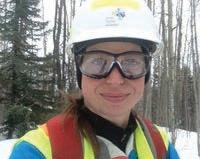
2008
Dean Fischer
Geomatics Engineering Technology
Dean sent this update: “After graduating I worked with FOCUS Surveys for two years before returning to school. I attended the British Columbia Institute of Technology from 2010 to 2012 and then returned to FOCUS after graduating. I began the process towards becoming an Alberta Land Surveyor (A.L.S.). Upon receiving my commission as an A.L.S., I moved back home to Medicine Hat as a Professional Land Surveyor and partner in a smaller firm called Benchmark Geomatics Inc. as of Jan. 1, 2018.”

College grads recognized as some of chamber’s Top 40 under 40





College graduates continue to populate the Lethbridge Chamber of Commerce and BDO’s list of the Top 40 under 40. Receiving recognition the last four months were:
Candice Boldt, Business Administration 2002.

Candice is the owner of Lethbridge Hearing Centre, a hearing centre using cutting-edge hearing technology, equipment and hearing devices. She was recognized for excellence in her field and her entrepreneurial spirit.
Shylo Harvey, Business Administration – Marketing student.
Shylo is the owner of Liquid Empire Plumbing and Heating Group, a locally owned company that specializes in residential and commercial plumbing, gas fitting, heating and air conditioning projects. He was recognized for his dedication to quality and customer service that has made him a leader in his field.
Fergus Raphael, Communication Arts 2003
Fergus is the president of Tangle Media, a web and custom app design firm in Lethbridge focused on developing totally customized web-based software systems. He was recognized for being on the leading edge of internet development and media for nearly two decades.
Jennifer McCarthy, Interior Design and Merchandising 2004
Jennifer is the owner of Teacup Tiny Homes, a tiny home builder in Lethbridge specializing in functional design and residential construction. She was recognized for her entrepreneurial spirit, and for bringing attention to Lethbridge and the region through the Tiny Home movement.
Nicole Reynolds, Business Administration 2011
Nicole is the Human Resources Manager at North and Company LLP, a law firm providing legal services to clients throughout southern Alberta since 1973. She was recognized for her dedication to helping students and those in the HR profession.
Jeremy Rickaby, Multimedia Production 2008
Jeremy is the creative director, senior designer and CEO of Hybrid Media Ltd., a team of marketers, artists, programmers and copywriters who provide first-class marketing solutions for all types of businesses. He is also lead designer for Citizen Sheep Clothing, an urban lifestyle clothing brand. He was recognized for his entrepreneurial spirit and dedication to helping his clients.
47
Where are they now?
1995
April 27 : @LowaBeebe
Today, I am honored to be receiving the 2018 Esquao Award for Community Involvement at tonight’s award show Lowa Beebe (Information Specialist 1996 )

1996
Karen Crowshoe
Criminal Justice
2006
Megan Catalano
Communication Arts
Megan is currently the communications manager for the District of Saanich, B.C. Before that, she worked in the communications departments at Royal Roads University in Victoria, B.C. and at Lethbridge College.

2005
Sidney Gaudette
Criminal Justice – Policing
According to a June article in the Lethbridge Herald, Const. Sidney Gaudette was honoured at a ceremony at Rideau Hall in Ottawa in June, when Governor General Julie Payette presented him with a Medal for Bravery for his quick response to a 2012 incident near Sedgewick, west of Wainwright. Along with two other police officers, Gaudette came under fire while executing a search warrant at a farmhouse near Sedgewick. After he was shot, another officer provided cover for Gaudette while the gunfire continued. Later, despite his injuries, Gaudette was able to provide cover for a third officer before the situation was resolved, and the wounded officers were taken to safety – and then to hospital. Gaudette is now stationed with the RCMP in Lethbridge.
Judge Karen Crowshoe from the Piikani Nation was officially sworn in as Alberta’s first female First Nations Provincial Court Judge in April. According to an article from the CBC, Crowshoe grew up on the Piikani First Nation in a three-room home shared by 11 family members. In 1994, she was the first Blackfoot woman to be called to the Alberta Bar. Crowshoe has acknowledged the power of her story to inspire others and credits her parents with pushing her to “strive every day to overcome the challenges that plague Indigenous people,” according to a statement prepared ahead of the ceremony by Alberta’s provincial court. After completing her studies at the college, Crowshoe earned a Bachelor of Management degree from the University of Lethbridge in 1989 and then a Bachelor of Laws degree from UBC in 1992. She articled at Walsh Wilkins Creighton law firm and practiced there for 13 years until opening her own practice in 2007. Photo courtesy Lowa Beebe.
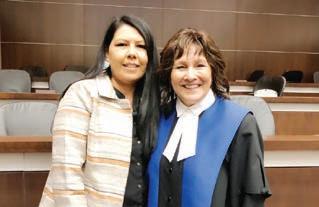
Jeremy Langemann
Culinary Careers
Jeremy was named executive chef of the St. Charles Country Club in Winnipeg in April. Before that, he had spent four years working as a culinary instructor at Paterson GlobalFoods Institute and more than two years as the executive chef at Fairmont Hotels and Resorts in Winnipeg.
1992
Mark Jacober Communication Arts
Since leaving Lethbridge College, Mark has worn many hats. Most recently he shared that he was working as a research analyst at MacEwan University.
1991
Kristi Bennett
Office/Computer Skills Development
Kristi sent the Alumni office this update: “After 18 years and six children, I was interested in entering the workforce again and was directed to attend a semester of secretarial courses to upgrade my skills. My first job after completing that semester was with a law office. I was not a legal secretary, but I assisted with accounting and real estate. After 1½ years, my husband, Richard Morris Bennett, was transferred to Red Deer where I began taking classes at Red Deer College and enrolled in their collaborative program with the University of Alberta Education. Beginning that program in 1998, I finished my last two years in Red Deer graduating with my Bachelor of Education in 2000. I credit Lethbridge College for helping me to feel the confidence to go back to school and to get the education that I had desired so long ago. Thank you for that opportunity to become a life-long learner and an example to my children. I now have been in Canada for 50 years; have become a Canadian citizen; celebrated my 50th anniversary in September, and am a grandmother to 31 (soon to be 32) grandchildren.”
48 | FALL 2018
1991 Jennifer Cook
Criminal Justice – Policing
Jennifer sent the Alumni office this update: “I moved to The Pas immediately after graduation. I worked odd jobs and then began at the local newspaper in the newsroom in 1993. I left the newsroom and pursued a career in marketing and then returned to the paper in 2002 in advertising sales and eventually general manager. I also run a fitness training centre that includes karate, boxing, boot camp and personal training. I continue to speak highly of the Criminal Justice program I completed, and while I didn’t ultimately pursue a career in policing, the course material and college class experiences have served me well in other aspects of my life.”
1988 Randy Ward Criminal Justice
After spending 27 years on the force, Randy retired from the Lethbridge Police Service in 2013. Since hanging up his uniform Randy has authored a book titled, You Can’t Make this Sh#t Up: Policing through Stories. The book chronicles some of his most unbelievable stories from his time serving and protecting. In an interview, the local author told Lethbridge News Now, “my motivation for the book is to show you that there is tragedy in policing, there is unpredictability, there is humour – lots of humour at times, and you have to have that in order to survive.” Randy’s book is available on Amazon.ca and locally at Lethbridge Tactical Supply and Chapters.
Rhonda Doram Communication Arts
“After various media-related jobs in Alberta, and an 18-year career in printing and manufacturing in the Vancouver area, my heart led me to my true calling,” Rhonda told the Alumni office. “In
J.P. Gentile (Community Services and Therapeutic Recreation 1996)
J.P. has felt at home since the moment he stepped on the Lethbridge College campus more than 20 years ago. Studying Community Services and Therapeutic Recreation was a natural fit for J.P., who knew his passion lied within athletics and community engagement. He was involved with various departments after completing his studies and has found a way to stick around ever since. J.P. now heads the Campus Recreation department of the Lethbridge College Students’ Association, where he has been dedicated to bettering the lives of students for 20 years. “The reason I have been doing this for 20 years is that every year there is a new batch of people walking on campus and a new group of people you can build a relationship with,” he says. “The college has a unique sense of community that I don’t think you could get anywhere else.
J.P. is often seen walking the halls in an outlandish outfit perfectly tailored for any given season or activity – from St. Patrick’s Day to Christmas. The mere sight of a head-to-toe moustache suit would be enough to prompt a smile from all those who cross his path, but add in the jovial grin plastered on his face and people aren’t likely to forget J.P. He says he can’t wait to continue to build on his legacy of serving as coach, mentor, friend and support system for many more years to come. “I’ve seen many faces come and go since I got here,” he says. “I don’t remember every face and I can’t remember every name, but I do know that every person who has walked these halls has had a huge impact on how amazing my time here has been.”

seeing the effects of aging and lack of suitable supports available for my own grandmother to remain independent in her own home in Coaldale, I became involved and it changed my entire life. I began assisting in coordinating her care and very soon had more than a dozen ‘clients!’ Recognizing the vast and unfulfilled need, I launched my own in-home senior support company in 2008 named HoneyDo Lifestyle Assistant to assist elders to live safely and successfully in their own home, wherever that may be. Running a quickly growing
business has been a steep learning curve and required quick-thinking, adaptability, and tenacity.” HoneyDo has grown from a solo venture to an incorporated entity with over 25 employees, roughly doubling year over year. HoneyDo Lifestyle Assistant received the 2017 Air Miles Small Business Achievement Award for “Social Venture of the Year” and appeared in Maclean’s magazine, was voted 2017 and 2018 Readers’ Choice winner for “Best Seniors Services,” and received the 2016 Rotary Clubs of Delta Business Ethics Award.
49
THE LAST WORD
Illustrated by Eric Dyck

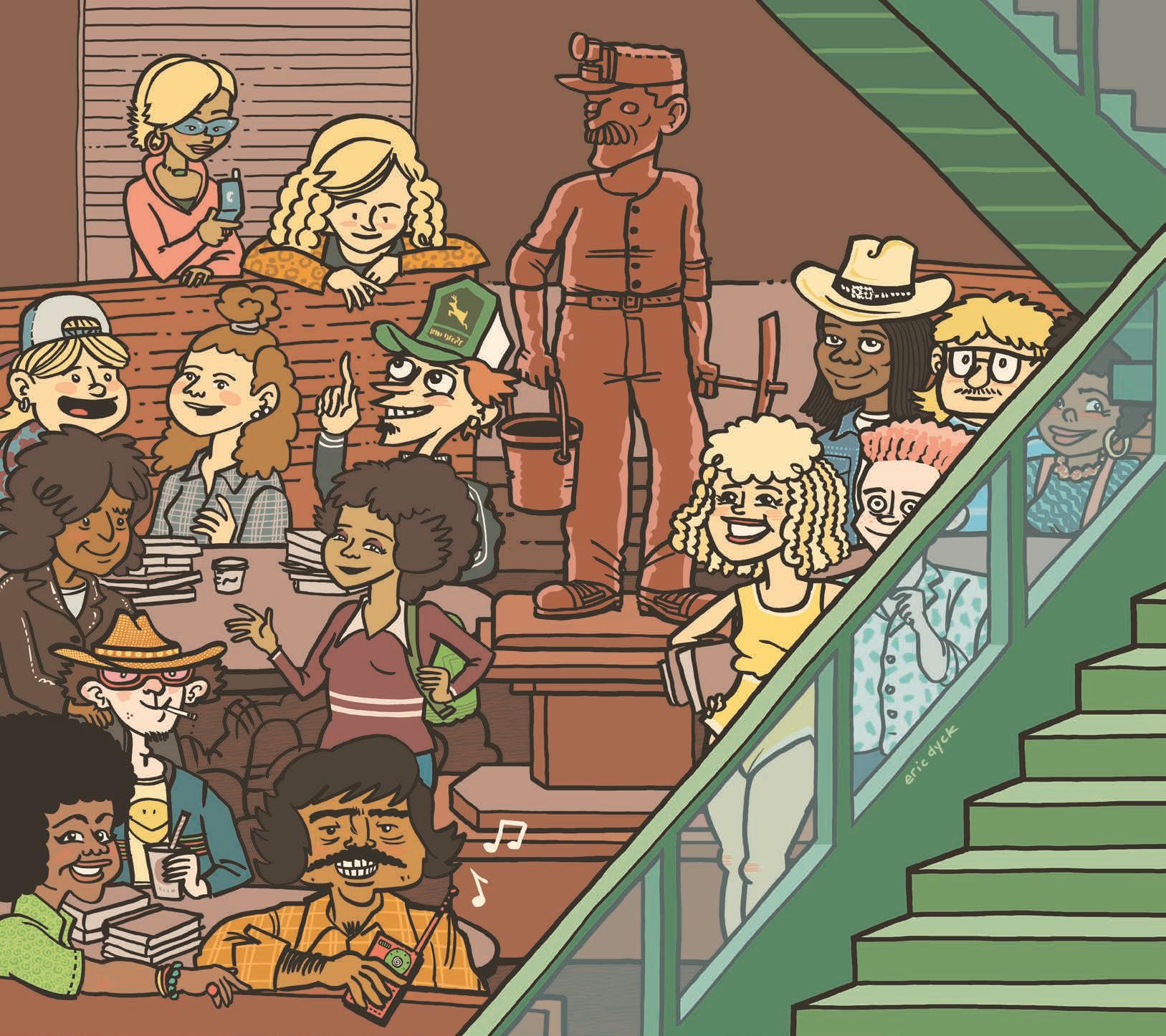
We asked a few LC alumni to tell us about the fashions they rocked during their college days –the ones they wish could be forgotten as well as the ones worthy of bringing back. Here’s what our alumni had to say:
Ok, maybe we rocked the turtle neck a bit too often and the white tube socks weren’t a good idea, but all in all nothing made me shudder. That may be because, for the most part, LCC was a rock school, not a disco school – more Pink Floyd than Saturday Night Fever. Now the HAIR, that is a totally different matter – too long, too messy, too close to mullet status and way too tight perms – but at least we still had it!
Rick Lewchuk Broadcast Journalism
1979
My husband Bill and I met at Lethbridge College. How could I not resist his mullet? Spikes on top, long hair in the back. Ugh. And you weren’t ready for classes if you didn’t tease your hair for an hour or make sure your bangs were gloriously back-combed in a strange looking fringe. Also cringe worthy was the trend of wearing ultra short shorts.
Lisa Ford Communication Arts 1983
Some of my most frequented outfits included pretty much anything leopard print, belted shirts and dresses, my LCSA T-shirts and bootcut jeans. While I don’t rock the belted looks or my LCSA T-shirt as much as I used to, I am still a big fan of animal print. I jokingly consider it to be my neutral wardrobe piece!
Alex Kulas-Carnio Business Administration 2012
The last word
52 | FALL 2018
NEXT ISSUE: The last is word is yours...
What are your best Barn stories?
Did you throw your boots over the rafters after graduation? Watch or perform in a cabaret? Play snooker? Attend Halloween parties? Send us your story (max 200 words) and a photo of yourself, and we’ll share a sampling with readers in our Winter issue.
Just email WHMagazine@lethbridgecollege.ca. You can also share your stories socially by tagging @LethCollege and #LastWordLC. We can’t wait to read your submissions!

KODIAKS COUNTRY This is
25 PER CENT OFF!
Show this magazine to receive 25% off one
Cross country running
Sept. 22 Lethbridge
Oct. 26-27 ACAC
Nov. 8-11 CCAA
Indoor track
March 8-9 ACAC Championships
March 15-17 ACAC Championships @
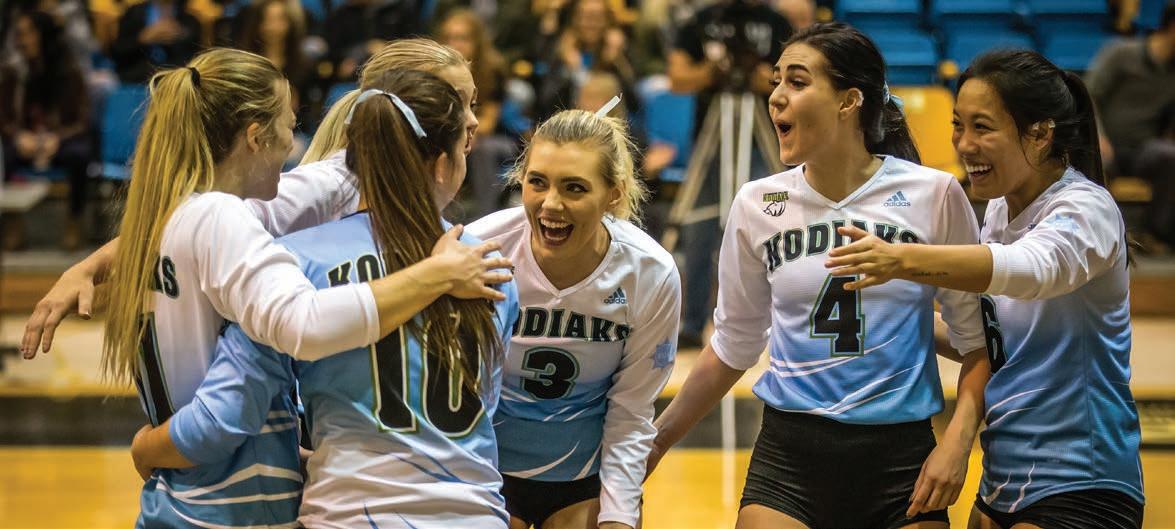
This schedule is subject to change. For up-to-date game times, visit: gokodiaks.ca
College clothing item during the month of September at the Lethbridge College Bookstore. lc_kodiaks
2018–19 Kodiaks home game schedule W M Volleyball
Oct. 19 SAIT 6 PM 8 PM Oct. 27 Ambrose 6 PM 8 PM Nov. 2 Briercrest 6 PM 8 PM Nov. 3 Briercrest 1 PM 3 PM Nov. 10 Medicine Hat 6 PM 8 PM Nov. 23 Olds 6 PM 8 PM Nov. 24 Olds 1 PM 3 PM Jan. 10 Medicine Hat 6 PM 8 PM Jan. 19 SAIT 6 PM 8 PM Jan. 31 Ambrose 6 PM 8 PM Feb. 8 Red Deer 6 PM 8 PM Feb. 9 Red Deer 1 PM 3 PM Feb. 20-23 ACAC Championships March 6-9 CCAA Nationals Basketball W M Oct. 13 SAIT 6 PM 8 PM Oct. 26 Medicine Hat 6 PM 8 PM Nov. 3 Olds 6 PM 8 PM Nov. 24 Red Deer 6 PM 8 PM Jan. 4 Medicine Hat 6 PM 8 PM Jan. 12 St. Mary’s 6 PM 8 PM Jan. 18 SAIT 6 PM 8 PM Feb. 2 Ambrose 6 PM 8 PM Feb. 15 Briercrest 6 PM 8 PM Feb. 16 Briercrest 1 PM 3 PM Feb. 27 - March 2 ACAC Championships March 13-16 CCAA Nationals W M Soccer Sept. 8 SAIT 2 PM 4 PM Sept. 29 Olds 2 PM 4 PM Oct. 6 Ambrose 12 PM 2 PM Oct. 7 Medicine Hat 12 PM 2 PM Oct. 20 Red Deer 2 PM 4 PM Oct. 21 Lakeland 12 PM 2 PM Oct. 26-28 ACAC Championships
7-10 CCAA Nationals
Nov.
Championships
Nationals
Futsal
Lethbridge
College
Lethbridge
@LC_Kodiaks











































 Moji Taiwo’s new book is a memoir that chronicles her journey as an immigrant in Canada.
Moji Taiwo’s new book is a memoir that chronicles her journey as an immigrant in Canada.





















 { Dr. Nick Savidov, senior research scientist at Lethbridge College }
{ Dr. Nick Savidov, senior research scientist at Lethbridge College }





 Dayne Adam, a 2018 Multimedia Production graduate used extended reality – or XR – to create his second-year capstone project.
Dayne Adam, a 2018 Multimedia Production graduate used extended reality – or XR – to create his second-year capstone project.




























